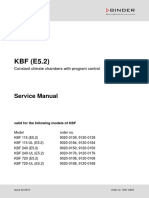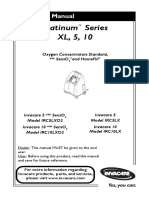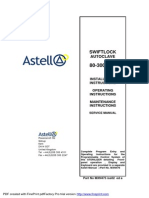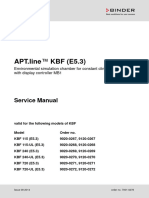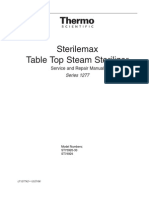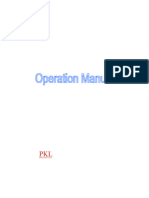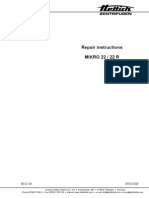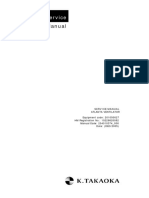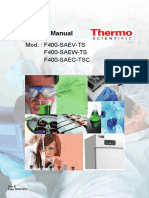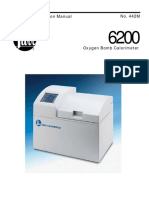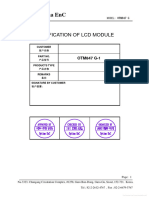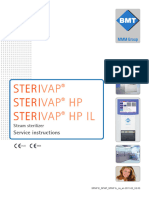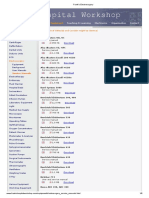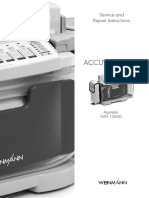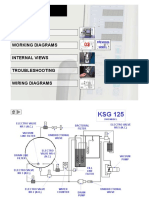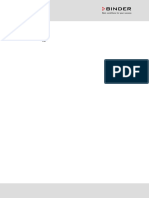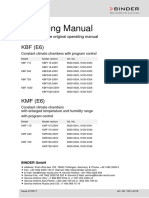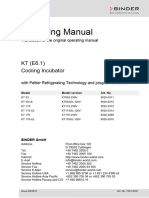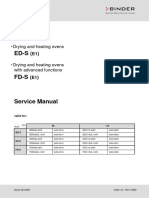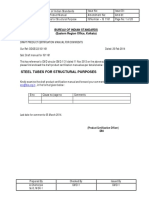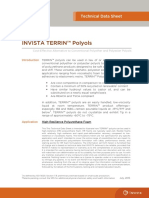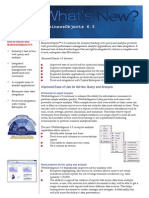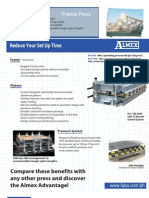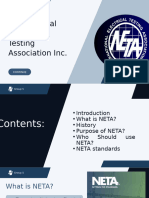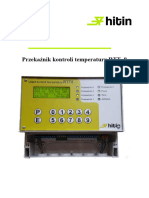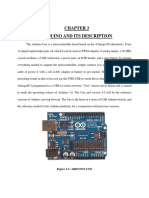SM KBF (E2.1) 12-2013 - en
SM KBF (E2.1) 12-2013 - en
Uploaded by
Victor RuizCopyright:
Available Formats
SM KBF (E2.1) 12-2013 - en
SM KBF (E2.1) 12-2013 - en
Uploaded by
Victor RuizOriginal Title
Copyright
Available Formats
Share this document
Did you find this document useful?
Is this content inappropriate?
Copyright:
Available Formats
SM KBF (E2.1) 12-2013 - en
SM KBF (E2.1) 12-2013 - en
Uploaded by
Victor RuizCopyright:
Available Formats
™
APT.line KBF (E2.1)
Environmental simulation chambers for constant climatic conditions
with display controller MB1 and humidity control board
Service Manual
valid for the following models of KBF:
Model order no. from serial no.
KBF 115 9x20-0093 04-65200
KBF 240 9x20-0094 05-77700
KBF 720 9x20-0096 04-67500
KBF-ICH 240 9x20-0066 05-77700
KBF-ICH 720 9x20-0068 04-67500
Issue 12-2013 order no. 7001-0122
Service Manual
Imprint
Imprint
Manufacturer:
BINDER GmbH
Address Post office box 102
D-78502 Tuttlingen
Tel. +49 7462 2005 0
Fax +49 7462 2005 100
Internet http://www.binder-world.com
E-mail info@binder-world.com
Service Hotline +49 7462 2005 555
Service Fax +49 7462 2005 93 555
Service E-Mail service@binder-world.com
Service Hotline USA +1 866 885 9794 or +1 631 224 4340 x3
Service Hotline Asia Pacific +852 39070500 or +852 39070503
Service Hotline Russia and CIS +7 495 98815 17
The reproduction, distribution and utilization of this document as well as the communication of its content to
others without explicit authorization are prohibited. Offenders will be held liable for the payment of damages.
All rights reserved in the event of the grant of a patent, utility model or design.
BINDER GmbH, 2007
Service Manual KBF (E2.1) 12-2013 3
Table of contents
Table of contents
1 Preface ........................................................................................................................... 6
1.1 General guidelines .......................................................................................................... 6
1.2 Syntax ............................................................................................................................. 6
1.3 Safety instructions structure ............................................................................................ 7
2 Safety instructions ........................................................................................................ 9
2.1 Qualification of service personnel .................................................................................... 9
2.2 Dangers ........................................................................................................................ 10
3 Preparation of service tasks ....................................................................................... 12
4 Maintenance ................................................................................................................ 13
5 Troubleshooting .......................................................................................................... 17
5.1 General electrical faults ................................................................................................. 18
5.2 Faults of the heating system .......................................................................................... 20
5.3 Faults of the cooling system .......................................................................................... 21
5.4 Faults of the humidity system ........................................................................................ 22
6 Check for electrical safety .......................................................................................... 25
7 Repair work at the housing......................................................................................... 26
7.1 Replacing the housing cover at the front and the air shielding plate .............................. 26
7.2 Replacing the rear panels.............................................................................................. 28
8 Repair work at the housing door ................................................................................ 29
8.1 Testing of closeness between housing door and sealing ............................................... 29
8.2 Adjusting the housing door ............................................................................................ 29
8.3 Replacing the instrument box ........................................................................................ 31
8.4 Replacing the power switch (-1S1 ) or light switch (-9S1 ) ............................................. 33
8.5 Opening the interior side of the housing door ................................................................ 34
8.6 Replacing the door switch (-7S1 ).................................................................................. 36
8.7 Replacing the closing device of the housing door .......................................................... 37
8.8 Testing and replacing door with the heating cable (-3E2 ).............................................. 39
8.9 Replacing the housing door ........................................................................................... 41
9 Repair work at the inner chamber .............................................................................. 43
9.1 Replacing the door sealing ............................................................................................ 43
9.2 Replacing the glass doors and the catches ................................................................... 44
9.3 Replacing the fan (-3M1, -3M2 ) .................................................................................... 45
9.4 Replacing the Pt100 temperature sensor (-2B1, -2B2) .................................................. 47
9.5 Replacing the humidity sensor incl. circuit board ........................................................... 50
9.6 Replacing the inner chamber ......................................................................................... 52
9.7 Testing and replacing of the heater (-3E1… -3E3 ) ........................................................ 54
10 Repair work at electric und electronic ....................................................................... 57
10.1 Replacing the miniature fuse (-1F1) .............................................................................. 57
10.2 Replacing the power cord .............................................................................................. 58
10.3 Replacing the suppressor capacitor (-1Z1) .................................................................... 59
10.4 Replacing the temperature fuse (-1F2) .......................................................................... 60
10.5 Pulling the electric mounting plate out of the machine room .......................................... 62
10.6 Components of the electric mounting plate .................................................................... 64
10.7 Replacing the contactor (-4K2) ...................................................................................... 65
10.8 Replacing a solid state relay (-3K1, -4K1, -6K1, -6K2) ................................................... 66
10.9 Replacing the controller (-2N1, -2N2 ) ........................................................................... 67
4 Service Manual KBF (E2.1) 12-2013
Table of contents
11 Repair work at the humidity system .......................................................................... 69
11.1 Replacing the I/O-switch (-6S1 ) of the humidity system ................................................ 69
11.2 Replacing 24 V power supply unit (-1T1 ) ...................................................................... 70
11.3 Replacing the humidity control board (-7N1 )................................................................. 71
11.4 Removing the water from the steam cylinder ................................................................. 72
11.5 Replacing the fresh water valve (-8Y3) .......................................................................... 73
11.6 Replacing the steam hose ............................................................................................. 74
11.7 Replacing the steam cylinder ........................................................................................ 75
11.8 Replacing the electrodes for steam generation.............................................................. 77
11.9 Attaching a separating plate into the steam cylinder ...................................................... 79
11.10 Cleaning the drainage pump (-8M1) and replacing the pump sealings .......................... 80
11.11 Replacing the drainage pump (-8M1) ............................................................................ 81
12 Repair work at the cooling system ............................................................................. 83
12.1 General information ....................................................................................................... 83
12.2 Required tools for repairing the cooling system ............................................................. 83
12.3 Testing the components of the cooling system .............................................................. 84
12.4 Replacing the solenoid valves (-5Y1, -8Y1, -8Y2 ) ........................................................ 85
13 Spare parts ................................................................................................................... 86
14 Calibration and adjustment of temperature and humidity control ........................... 89
14.1 General execution of the calibration .............................................................................. 89
14.2 Calibrating and adjusting points..................................................................................... 90
14.3 Calibrating and adjusting the temperature control ......................................................... 90
14.4 Calibrating and adjusting the humidity control ............................................................... 95
15 Description of special unit components .................................................................... 99
15.1 Cooling system.............................................................................................................. 99
15.2 Humidity system .......................................................................................................... 102
16 Revision history ........................................................................................................ 106
Service Manual KBF (E2.1) 12-2013 5
Preface
1 Preface
1.1 General guidelines
This service manual describes the maintenance, the trouble shooting, the repair, the calibration
and the adjustment of the KBF 115, 240 and 720 with MB1 controller and humidity control board.
Sections only concerning units with options according to the BINDER pricelist are indicated.
The figures in this service manual almost show the service work at the KBF 115. The service work
of the KBF 240 and 720 is to perform analogical. In particular cases additional figures of a KBF 240
or 720 are given.
The repair of the cooling system must only be performed by service personnel having specialized
training as cooling technician and special tools must be available.
This service manual is aimed at service personnel who should maintain, repair, calibrate and adjust
a KBF.
References about the required qualification of the service personnel can be found in chap. 2.1
on page 9.
Before starting the service work at a KBF compare order and serial number of the unit with the
validity note on the front page of this service manual.
The service manual of the KBF will be updated if necessary.
Always use the latest version of the service manual.
In case of doubt about the validity of this service manual contact the Binder Service Hotline (see
Imprint).
Wiring diagrams and refrigeration cycles are published separately. The actual documents can be
ordered at the Binder Service Hotline.
All information about initial operation, normal operation, cleaning, alarm and error messages of the
KBF with controller MB1 can be found in the relevant operating manual.
1.2 Syntax
Syntax Meaning
(-1A1) Marking of electrical equipment and electric contacts
<button> Button to be pushed
"text" Displayed text or text to be keyed in
6 Service Manual KBF (E2.1) 12-2013
Preface
1.3 Safety instructions structure
These service manual employ the terms and symbols below to describe dangerous situations, in
line with the harmonization of ISO 3864-2 and ANSI Z535.4.
1.3.1 Warning levels
Dangers are indicated, according to the severity and likelihood of their consequences, by a word to
attract attention, with the associated warning color and any appropriate safety symbol.
DANGER!
Indicates an imminently hazardous situation that, if not avoided, will result in
death or serious (irreversible) injury.
WARNING!
Indicates a potentially hazardous situation which, if not avoided, could result
in death or serious (irreversible) injury.
CAUTION!
Indicates a potentially hazardous situation which, if not avoided, may result in
moderate or minor (reversible) injury.
CAUTION!
Indicates a potentially hazardous situation which, if not avoided, may result in damage of
the product and/or its functions or of a property in its ambiance.
Service Manual KBF (E2.1) 12-2013 7
Preface
1.3.2 Safety symbols
Danger of injury!
Follow all the directions indicated by the safety symbol in order to avoid injury
or death.
Danger of electric shock!
Harmful substances! Danger to health.
Biohazard! Danger of infection.
Danger of burnings by hot surfaces!
Danger of frostbites by cold surfaces!
Danger of cutting injuries!
Danger of injuries by jumping off mechanical components!
1.3.3 Imperative symbols
Pull out the power plug!
Wear protective goggles!
Wear protective gloves!
1.3.4 Information symbols
Important information
8 Service Manual KBF (E2.1) 12-2013
Safety instructions
2 Safety instructions
2.1 Qualification of service personnel
WARNING!
If the KBF is maintained or repaired incorrectly, there is a risk of malfunction
which could cause harm to human beings and material damage to the
equipment and samples.
CAUTION!
If the KBF is calibrated or adjusted incorrectly, there is a risk of malfunction which could
cause material damage to the samples and false test results.
The KBF should only be maintained, repaired, calibrated and adjusted by
qualified persons.
To be able to carry out the service work the enforcing personnel must be qualified and familiar with
the service and the operation of the KBF.
Sufficient qualification is achieved by:
Electro technical training
Technical training by BINDER GmbH
Knowledge of the present service manual
Knowledge of the operating manual of the KBF to be serviced
Experience in servicing environmental simulation chambers
The repair of the cooling system must only be carried out by service personnel with specialized
training as cooling technician.
Service Manual KBF (E2.1) 12-2013 9
Safety instructions
2.2 Dangers
DANGER!
Danger of electric shock.
Danger to life.
The unit must be switched off prior to performing most of the service tasks
described below.
Disconnect the unit from the facility-side power supply to make sure that it
can not be switched on again by mistake!
If the service task requires that the unit be switched on, a second person
must be called in to switch off the unit in the case of an emergency!
DANGER!
Danger of electric shock.
Danger to life.
The unit must not be operated if the check for electrical safety fails.
The check for electrical safety has to be done during the recommended
annual maintenance work.
The check for electrical safety has to be done after every repair.
WARNING!
Contamination of the device with toxic, infectious or radioactive
substances.
Danger of intoxication.
Danger of infection.
Never service a unit with sticking toxic or radioactive substances or
sources of infection.
Never service a unit before the form “Contamination clearance certificate -
Declaration of harmlessness with regard to safety and health” is
completely filled out.
Prior to any service tasks, let the unit free from any sticking toxic or
radioactive substances or sources of infection by the operating staff.
Prior to any service tasks, a person in charge of the operating staff must fill
out the form “Contamination clearance certificate - Declaration of
harmlessness with regard to safety and health”.
The refrigerant R 134A must not enter the atmosphere.
Before opening the refrigeration cycle, the refrigerant must be sucked off completely.
Dispose of the refrigerant according to the international regulations.
10 Service Manual KBF (E2.1) 12-2013
Safety instructions
CAUTION!
Danger of cutting injuries by sharp edges!
Wear protective gloves against cutting injuries during mounting and
dismantling of inner chamber parts because the sheet metal components
are sharp-edged.
CAUTION!
Danger of burnings by hot surfaces and water!
The unit must be cooled down prior to performing of the service tasks of
the inner chamber, the interior side of the housing door, the heater and the
humidity system.
CAUTION!
Danger of frostbites by cold surfaces!
The unit must be warmed up prior to performing of the service tasks
described below especially the service tasks of the inner chamber and the
cooling system.
CAUTION!
Danger of injuries by jumping off mechanical components!
Wear protective goggles when dismantling the steam cylinder because
the locking clips of the cover of the steam cylinder are under clamping and
can jump off when loosening.
Service Manual KBF (E2.1) 12-2013 11
Preperation of service tasks
CAUTION!
Danger of damaging the electronic!
The instrument box must only be opened at a workstation which is equipped with all
necessary protective measures against electrostatic discharge.
Circuit boards might be damaged by electrostatic discharges, penetrating particles like
dust and touching of its components.
CAUTION!
Danger of mechanical damages!
Never let mechanical components hang at electric cables.
Electric cables are not appropriate to hold bigger components and will be damaged if
you do so.
3 Preparation of service tasks
WARNING!
Contamination of the device with toxic, infectious or radioactive
substances.
Danger of intoxication.
Danger of infection.
Never service a unit with sticking toxic or radioactive substances or
sources of infection.
Never service a unit before the form “Contamination clearance certificate -
Declaration of harmlessness with regard to safety and health” is
completely filled out.
Prior to any service tasks, let the unit free from any sticking toxic or
radioactive substances or sources of infection by the operating staff.
Prior to any service tasks, a person in charge of the operating staff must fill
out the form “Contamination clearance certificate - Declaration of
harmlessness with regard to safety and health”.
Climatic chambers series KBF are designed for exact conditioning of harmless materials
(see chap. “Intended use” of the operating manual).
Nevertheless due to the use by the operating company it might be possible that the unit is
contaminated with toxic, infectious or radioactive substances inside and outside of the inner
chamber.
For the safety of the service personnel prior to any service tasks the unit must be freed from
any sticking toxic or radioactive substances or sources of infection by the operating staff.
Prior to any service tasks, a person in charge of the operating staff must fill out the form
“Contamination clearance certificate - Declaration of harmlessness with regard to safety and
health”.
The form can be found in chap. “Contamination clearance certificate” of the operating manual
or can be ordered at the Binder Service Hotline.
12 Service Manual KBF (E2.1) 12-2013
Maintenance
4 Maintenance
DANGER!
Danger of electric shock.
Danger to life.
The unit must not be operated if the check for electrical safety fails.
The check for electrical safety has to be done during the recommended
annual maintenance work.
The check for electrical safety has to be done after every repair.
All mechanical and electrical parts of the KBF should be visually checked, tested and maintained
by service personnel annually.
The recommended maintenance work is described in Table 1.
Table 1: Recommended annual maintenance work
Component Check step
Action
Housing
Sheet metal components Check the housing for mechanical damages and corrosion
If necessary, replace the damaged sheet metal components (chap. 6,
page 25)
Housing door
Housing door, Check the adjustment and the tight fit of the housing door
door hinges, Check the smooth-running of the door hinges
lugs If necessary, adjust the door hinges and lugs (chap. 8.2, page 29)
Instrument box Check the instrument box for tight fit and cracks
If necessary, tighten or replace the instrument box
(chap. 8.3, page 31)
Power switch (-1S1) Check the function of the power switch
If necessary, replace the switch (chap. 8.6, page 36)
Buttons of instrument box Check the function of the buttons by performing different inputs (see
operating manual)
If necessary, replace the defective switch mat (chap. 8.3, page 31) or
the controller display (chap. 10.9.1, page 67)
Housing door Check the housing door for mechanical damages and corrosion
If necessary, replace the housing door (chap. 8.9, page 41)
Door switch (-7S1) Check the tight fit and the mechanical function of the door switch
If necessary, replace the door switch (chap. 8.6, page 36)
Interior side of housing door Check the interior side of housing door for mechanical damages and
corrosion
If necessary, replace the interior side of housing door (chap. 8.5,
page 34)
Closing device Check the smooth-running and the function of the closing device
If necessary, replace the closing device (chap. 8.7, page 37)
Service Manual KBF (E2.1) 12-2013 13
Maintenance
Inner chamber
Door sealing Check the door sealing for wear, tight fit and damages
If necessary, replace the door sealing (chap. 9.1, page 43)
Glass door, Check the glass door, the door hinges and the catches for damages
catches Check the strength of the adhesion between the glass door and the
hinges resp. the handle
Check the adjustment of the glass door
Check the smooth-running of the glass door
If necessary, adjust the glass door and the catches (chap. 9.2,
page 44)
If necessary, replace the glass door (chap. 9.2, page 44)
Fan(-3M1, -3M2) Check the fan(s) for damages, corrosion, function and noise emission
If necessary, replace the fan (chap. 9.3, page 45)
Humidity sensor (KBF 115/240: Check the humidity sensor for fouling
-2B2 ; KBF 720: -2B3 ) If necessary, replace the filter cap of the humidity sensor
Inner chamber Check the sheet metal components of the inner chamber for
mechanical damages and corrosion
If necessary, replace the damaged sheet metal components
(chap. 9.6, page 52)
Machine room
Machine room Check the machine room for fouling, mechanical damages and
corrosion
If necessary, clean the machine room from dust and similar impurities
If necessary, check by what mechanical damages and corrosion are
caused and eliminate the causes
Electric and electronic
Power plug Check the power plug and the power cord for damages
Power cord If necessary, replace the power cord with the power plug
(chap. 10.2, page 58)
I/O-switch of humidity system Check the function of the I/O-switch
(-6S1) If necessary, replace the I/O-switch (chap. 11.1 page 69)
Electric mounting plate Check the electric mounting plate for fouling, mechanical damages
and corrosion
Check the tight fit of the components of the electric mounting plate
Check the cables being connected to the components of the electric
mounting plate for sufficient fixing and damages
If necessary, clean the electric mounting plate and its components
from dust and similar impurities
If necessary, replace components of the electric mounting plate
(chap. 10.6 ff., page 64)
Fix lose cables and replace damaged cables
Electric and electronic Check the electric and electronic components in the machine room for
components in the machine room tight fit, fouling, mechanical damages and corrosion
Check the cables being connected to the electric and electronic
components in the machine room for sufficient fixing and damages
If necessary, replace electric and electronic components in the
machine room (chap. 10, page 57)
Fix lose cables and replace damaged cables
14 Service Manual KBF (E2.1) 12-2013
Maintenance
Steam generation system
Fresh water hose, Check the fresh and waste water hoses for wear and damages
waste water hose If necessary, replace the fresh or waste water hose (see operating
manual)
Fresh water valve (-8Y3) Remove the fresh water hose and clean the connection port of the
fresh water valve
Check the fresh water valve for damages
Check the function of the fresh water valve (chap. 15.2.3, page 103)
If necessary, replace the fresh water valve (chap. 11.5, page 73)
Steam hose Check the steam hose for wear and damages
If necessary, replace the steam hose (chap. 11.6, page 74)
Steam cylinder Remove lime and other deposits out of the steam cylinder
Check the outer and inner side of the steam cylinder for leakage, wear
and damages
Check the o-rings for the cylinder flange and the support foot for
damages
If necessary, replace the steam cylinder (chap. 11.7, page 75)
If necessary, replace the o-rings (chap. 11.8, page 77)
Electrodes for steam generation Check the electrodes for steam generation for abrasion and deposits
If necessary, remove the deposits mechanically or chemically with
antiliming agent.
If necessary, replace the electrodes for steam generation (chap. 11.8,
page 77)
If necessary, replace the steam cylinder (chap. 11.7, page 75)
Drainage pump (-8M1) Check the drainage pump for damages and corrosion
Check the function of the drainage pump (chap. 15.2.3, page 103)
If necessary, clean the drainage pump and replace the o-rings
(chap. 11.10, page 80)
If necessary, replace the drainage pump (chap. 11.11, page 81)
Cooling system
Components of the cooling Check all components of the cooling system, the piping and
system (piping etc.) particularly the soldering joints for fouling, damages and corrosion
If necessary, clean the components of the cooling system
If necessary, let a defective component replace or repair (chap. 12)
Insulation Check the insulation of the piping for damages
If necessary, seal damages of the insulation with appropriate
insulating material
Compressor Check the compressor for fouling, damages, corrosion and unusual
noise emission
If necessary, clean the compressor
If necessary, let the compressor replace (chap. 12, page 83)
Condenser with fan Check the condenser and the fan for fouling, damages and corrosion
Check the function of the fan
If necessary, clean the condenser and the fan
If necessary, let the condenser and the fan replace (chap. 12,
page 83)
Solenoid valves (-5Y1, -8Y1, -8Y2) Check the solenoid valves for fouling, damages and corrosion
If necessary, clean the solenoid valves
If necessary, replace a solenoid valve (chap. 12.3, page 84)
Safety checks
Check for electrical safety Check the unit for electrical safety (chap. 6, page 25)
If one of the checks fails, the unit must not be operated
If one of the checks fails, look for the possible causes and repair it
Operating manual Check if the operating manual is available (e. g. for safety instruction)
Service Manual KBF (E2.1) 12-2013 15
Maintenance
Controller
Controller display Check the function of the controller display by entering different
menus (see operating manual)
If necessary, replace the controller (chap. 10.9, page 67)
Set point setting Key in several set points for temperature and humidity and check if
the unit starts approaching this values(see operating manual)
Execute a troubleshooting, if the unit does not start approaching the
set points (chap. 5, page 17)
Temperature control Calibrate the temperature control (chap. 14, page 89)
If necessary, adjust the temperature control (chap. 14, page 89)
If necessary, replace the Pt100 temperature sensor (chap. 9.4,
page 47)
Humidity control Calibrate the humidity control (chap. 14, page 89)
If necessary, adjust the humidity control (chap. 14, page 89)
If necessary, replace the humidity sensor (chap. 9.5, page 50)
16 Service Manual KBF (E2.1) 12-2013
Troubleshooting
5 Troubleshooting
Alarm and error messages as well as basic measures the operator himself may
take to clear them are described in the KBF operating manual.
Please make sure these measures have been tried before looking further for
any other possible error causes.
The troubleshooting diagrams below are built up as follows:
Error pattern
Possible error cause Yes Remedial measure
No
Possible error cause Yes Remedial measure
Faults should be found by replacing components of the unit. Usually that will be the fastest method
of troubleshooting.
The sequence of the columns describing potential causes for errors, and the remedial actions to
clear the described error patterns, is mainly intended to facilitate basic error diagnosis and
clearance.
So it is recommended to work your way from top to bottom of the diagrams.
Notations between brackets and in italics, e.g. (-1S1), behind a component refer to the respective
equipment codes for this component, as specified in the wiring diagram, and in labels on some
parts inside the apparatus.
Note the safety instructions when troubleshooting!
Turn off the unit and disconnect it from the power supply.
Service Manual KBF (E2.1) 12-2013 17
Troubleshooting
5.1 General electrical faults
Operating state indication does not work
No indications on the controller displays
(-2N1)
No
Power plug (-X1) connected? Connect power plug
Yes
No
Power switch (-1S1) set to ON? Set power switch to ON
Yes
No
Facility-side power supply available? Ensure facility-side power supply
Yes
Replace miniature fuse (-1F1)
(chap. 10.1, page 57)
Look for possible causes for the fuse
blowing and clear them:
if contaminated with conductive dust:
clean the apparatus carefully
if the cables are mechanically
damaged: replace or insulate the cable
Miniature fuse (-1F1) blown? Yes in a professional manner
if cables or components are burned:
replace cable or component if possible
if the facility-side power supply is
defective: let the power supply repair
if the heater is defective: replace the
heater (chap. 9.7 page 54)
if the heating cable of the door is
defective: replace the inside of housing
door (chap. 8.8, page 39)
No
18 Service Manual KBF (E2.1) 12-2013
Troubleshooting
No Connect plug at the power switch (-1S1)
Plug at the power switch (-1S1) connected?
(chap. 8.3.1, page 31)
Yes
No Connect plug at the controller display (-2N1)
Plug at the controller display (-2N1) connected?
(chap. 10.9, page 67)
Yes
Yes Replace power switch (-1S1)
Power switch (-1S1) defective?
(chap. 8.3.1, page 31)
No
Plug of the cable from the No Connect plug of the cable from the controller
controller display (-2N1) connected to the display (-2N1) at the controller I/O-board
controller I/O-board (-2N2)? (-2N2) (chap. 10.9, page 67)
Yes
Yes Replace power cord with power plug (-X1)
Power cord with power plug (-X1) defective?
(chap. 10.2, page 58)
No
Controller I/O-board (-2N2) and/or controller Replace controller I/O-board (-2N2) and/or
display (-2N1) defective. controller display (-2N1) (chap. 10.9, page 67)
No
Replace temperature fuse (-1F3)
Temperature fuse is blown (-1F3) because of a Yes
(chap. 10.4, page 60)
controller error
Replace controller (chap. 10.9, page 67)
Service Manual KBF (E2.1) 12-2013 19
Troubleshooting
5.2 Faults of the heating system
Temperature of inner chamber does not
increase to set temperature
Controller displays operating parameters
Solid state relay (-3K1) defective? Yes Replace solid state relay (-3K1)
(chap. 10.8, page 66)
No
Contactor (-4K2) defective? Yes Replace contactor (-4K2)
(chap. 10.7, page 65)
No
KBF 115: heater (-3E1) defective?
KBF 240: heaters (-3E1, -3E2) defective? Yes
Replace heater (-3E1) (chap. 9.7, page 54)
KBF 720: heaters (-3E1, -3E2, -3E3)
defective?
No
Controller I/O-board (-2N2) defective. Yes
Replace controller (chap. 10.9, page 67)
Condensation at the glass door
Does the housing door fit close? No Adjusting the housing door
(chap. 8.1, page 29) (chap. 8.2, page 29)
Yes
KBF 115: Heating cable (-3E2) defective?
KBF 240: Heating cable (-3E3, -3E4) Replace interior side of housing door with
defective? Yes heating cable
KBF 720: Heating cable (-3E4, -3E5) (chap. 8.8, page 39)
defective?
20 Service Manual KBF (E2.1) 12-2013
Troubleshooting
5.3 Faults of the cooling system
For testing the function of the cooling system see chap. 12.3, page 84.
Temperature of inner chamber does not
decrease to set temperature
Controller displays operating parameters
No Adjusting the housing door
Does the housing door fit close?
(chap. 8.1, page 29) (chap. 8.2, page 29)
Replace door sealing (chap. 9.1, page 43)
Yes
Yes Let the Condenser with fan (-5M2) replace
Condenser with fan (-5M2) defective?
(chap. 12, page 83)
No
Yes Let the Compressor (-5M2) replace (chap. 12,
Compressor (-5M1) defective?
page 83)
No
Yes Replace solenoid valve cooling (-5Y1)
Solenoid valve cooling (-5Y1) defective?
(chap. 12.3, page 84)
No
Valve gate of solenoid valve cooling (-5Y1) Yes Let the valve gate replace
defective? (chap. 12, page 83)
No
Loss of refrigerant? Yes
Let the leak close (chap. 12, page 83)
No
Controller (-2N1, -2N2) defective? Yes
Replace controller (chap. 10.9, page 67)
No
Capillary tube (-J6) to plate evaporator cooling Yes Let capillary tube (-J6) replace
blocked? (chap. 12, page 83)
Service Manual KBF (E2.1) 12-2013 21
Troubleshooting
5.4 Faults of the humidity system
For testing the function of the cooling system see chap. 12.3, page 84.
Humidity of inner chamber does not
decrease to set humidity
Yes Let cooling system repair
Faults of the cooling system?
(chap. 12, page 83)
No
Solenoid valve dehumidification (-8Y1) or (-8Y2) Yes Replace solenoid valve dehumidification
defective? (-8Y1) or (-8Y2) (chap. 12.3, page 84)
No
Valve gates of solenoid valves dehumidification Yes Let the defective valve gate replace
(-8Y1) or (-8Y2) defective? (chap. 12, page 83)
No
Capillary tubes (-J4) or (-J4) to plate evaporators Yes Let blocked capillary tube (-J4) or (-J4)
dehumidification blocked? replace (chap. 12, page 83)
No
Yes Replace humidity controller board (-7N1)
Humidity controller board (-7N1) defective? (chap. 11.3, page 71)
No
Yes
Controller defective? Replace controller (chap. 10.9, page 67)
No
I/O-switch (-6S1) of the humidity system Yes Replace I/O-switch (-6S1) of the humidity
defective? system (chap. 11.1, page 69)
No
Yes Replace 24 V power supply unit (-1T1)
24 V power supply unit (-1T1) defective.
(chap. 11.2, page 70)
22 Service Manual KBF (E2.1) 12-2013
Troubleshooting
Humidity of inner chamber decreases
even if it is already below the set humidity
Steam cylinder does not contain water
Is the facility-side water supply closed? Yes Open facility-side water supply
(see operating manual)
No
Hose burst protection device interrupts the water Yes Release the hose burst protection device
supply? (see operating manual)
No
Fresh water connection of unit blocked? Yes Unscrew fresh water hose and clean
connection (see operating manual)
No
Yes Replace fresh water valve (-8Y3)
Fresh water valve (-8Y3) defective?
(chap. 11.5, page 73)
No
Yes Replace humidity controller board (-7N1)
Humidity controller board (-7N1) defective
(chap. 11.3, page 71)
Service Manual KBF (E2.1) 12-2013 23
Troubleshooting
Humidity of inner chamber decreases
even if it is already below the set humidity
Steam cylinder contains water
Humidity sensor incl. circuit board (-2B2) Yes Replace humidity sensor incl. circuit board
(chap. 9.5, page 50)
defective?
No
Solid state relay (-6K1) or (-6K2) defective? Yes Replace solid state relay (-6K1) or (-6K1)
(chap. 10.8, page 66)
No
Humidity controller board (-7N1) defective? Yes Replace humidity controller board (-7N1)
(chap. 11.3, page 71)
No
Controller (-2N1, -2N2) defective? Yes
Replace controller (chap. 10.9, page 67)
No
I/O-switch (-6S1) of the humidity system Yes Replace I/O-switch (-6S1) of the humidity
defective? system (chap. 11.1, page 69)
No
Contactor (-4K2) defective. Yes Replace contactor (-4K2)
(chap. 10.7, page 65)
24 Service Manual KBF (E2.1) 12-2013
Check for electrical safety
6 Check for electrical safety
DANGER!
Danger of electric shock.
Danger to life.
The unit must not be operated if one of the checks for electrical safety fails.
The check for electrical safety has to be done during the recommended
annual maintenance work.
The check for electrical safety has to be done after every repair.
During the recommended annual maintenance work (chap. 3, page 12) and after every repair
(chap. 7 to 11) a check for electrical safety has to be done.
This electrical safety check has to include the following tests:
Check of the protective conductor (PE)
Measuring of the leakage current
(Measuring of the insulating resistance is not possible for technical reasons.)
BINDER recommends to perform the electrical safety check according to the German standard:
DIN VDE 0701-1 September 2000
Instandsetzung, Änderung und Prüfung elektrischer Geräte, Teil 1: Allgemeine
Anforderungen
(Repair, modification and inspection of electrical appliance, Part 1: General requirements).
Alternatively the electrical safety check can be performed according to similar national standards
which include the specified tests above.
Irrespective of the used standard for the electrical safety check the following limit values must be
observed (Table 2).
Table 2: Limit values of the electrical safety check
Test Limit values
Value for the protective conductor resistance: 0.3
Check of the protective conductor
The open-circuit voltage of the measuring device has to be between 4 V and
(PE)
24 V AC/DC and the measuring current must not be under 0.2 A.
Value for the leakage current: 3.5 mA
The operating parameters of the unit for this test must be:
temperature set point: +90°C
Measuring of the leakage current
humidity system: on
humidity set pint: 90 %r.H.
for units with option “Interior lighting” or ICH: light on
Service Manual KBF (E2.1) 12-2013 25
Repair work at the housing
7 Repair work at the housing
7.1 Replacing the housing cover at the front and the air
shielding plate
Spare parts: KBF 115
Housing cover, lower front side 115 KBF/E2 order no. 8001-0111
Air shielding plate 115 KBF/E2 order no. 4001-0353
KBF 240
Housing cover, lower front side 240 KBF order no. 8001-0114
Air shielding plate 240 KBF/E2 order no. 4001-0366
KBF 720
Housing cover, lower front side 720 KBF order no. 8001-0115
Air shielding plate 720 KBF/E2 order no. 4001-0368
1. Disconnect the unit from the power supply.
2. Unscrew the screws (G) of the housing cover (F).
3. Push the housing cover (F) slightly downward in order to remove the lugs (H) out of their slots
in the housing plate.
4. Pull the housing cover (F) with the mounting brackets (E) forward out of the slots (A).
5. Push the housing cover (F) to the left over the lateral control panel (B) and remove it from the
unit.
6. Hold on to the air shielding plate (C) and unscrew the screws (D).
7. Remove the air shielding plate (C).
8. Install the air shielding plate (C) and the housing cover (F) by following steps 1 to 7 in reverse
order.
26 Service Manual KBF (E2.1) 12-2013
Repair work at the housing
A B C D E F G H
Figure 1: Replacing the housing cover at the front and the air shielding plate
A Slots for mounting brackets E Mounting brackets
B Lateral control panel F Housing cover
C Air shielding plate G Screws of housing cover
D Screws of air shielding plate H Lugs
Service Manual KBF (E2.1) 12-2013 27
Repair work at the housing
7.2 Replacing the rear panels
Spare parts: KBF 115
Rear panel 115 KB/E2 top order no. 4001-0388
Rear panel 115 KB/E2 bottom order no. 4001-0387
KBF 240
Rear panel 240 KB/E2 top order no. 4001-0399
Rear panel 240 KB/E2 bottom order no. 4001-0398
KBF 720
Rear panel 720 KB/E2a top order no. 4001-0343
Rear panel 720 KB/E2a bottom order no. 4001-0346
1. Disconnect the unit from the power supply.
2. Hold on to the lower rear panel (B) and unscrew the screws (A) and (C).
3. Hold on to the upper rear panel (E) and unscrew the screws (C) and (D).
4. Install both rear panels (B) and (E) by following step 1 to 3 in reverse order.
A B C D E
Figure 2: Dismantling rear panels
A Screws of the lower rear panel D Screws of the upper rear panel
B Lower rear panel E Upper rear panel
C Screws of both rear panels
28 Service Manual KBF (E2.1) 12-2013
Repair work at the housing door
8 Repair work at the housing door
CAUTION!
Danger of burnings by hot surfaces!
The unit must be cooled down prior to performing of the service tasks
described below especially the service tasks of the inner chamber, the
interior side of the housing door, the heater and the humidity system.
8.1 Testing of closeness between housing door and sealing
1. Put a normal writing paper between housing door(s) and sealing and close the door(s).
If the paper is jammed and does not slip, the door(s) fits close to the sealing.
2. Test the closeness along the whole sealing.
3. If the door(s) does not fit close to the sealing, adjust the housing door(s) (chap. 8.2, page 29)
or replace the sealing (8.1, page 43).
8.2 Adjusting the housing door
8.2.1 Adjusting the hinges (Figure 3)
1. Disconnect the unit from the power supply.
2. Remove the caps (B).
3. Loosen all screws (D) of the hinges a little so that the door (A) can be moved laterally within
the slots (E).
4. Adjust the door (A) and tighten all screws (D) of the hinges.
5. Test if the door(s) is (are) proper adjusted and close(s) tight by opening and closing it (them)
(chap. 8.1, page 29).
8.2.2 Adjusting the lugs (Figure 4)
1. Open the housing door to adjust the lugs (A).
2. By turning the adjusting screw (B) a lug (A) can be moved out of or into the housing.
3. Adjust all lugs (A) so that the closing device(s) of the door(s) (see chap. 8.7, page 37) can lock
into the lugs easily.
4. Test if the door(s) is (are) proper adjusted and close(s) tight by opening and closing it (them)
(chap. 8.1, page 29).
Service Manual KBF (E2.1) 12-2013 29
Repair work at the housing door
A B C D E
Figure 3: Adjusting the housing door
A Housing door D Screws of hinges
B Caps E Slots
C Clearance between door and housing
A B
Figure 4: Adjusting the lugs of the housing door
A Lug
B Adjusting screw
30 Service Manual KBF (E2.1) 12-2013
Repair work at the housing door
8.3 Replacing the instrument box
CAUTION!
Danger of damaging the electronic!
The instrument box must only be opened at a workstation which is equipped with all
necessary protective measures against electrostatic discharge.
Circuit boards might be damaged by electrostatic discharges, penetrating particles like
dust and touching of its components.
CAUTION!
Danger of mechanical damages!
Never let the instrument box hang at electric cables. Electric cables are not appropriate
to hold bigger components and will be damaged if you do so.
Spare parts: Instrument box MB1 MK/KBF complete order no. 8008-0130
or
Housing instrument box MB1 with lens order no. 8500-0006
Switch mat MB1, fivefold order no. 6002-0184
Switch mat MB1, threefold MK order no. 6002-0196
Filter pane MB1 I-Box order no. 6002-0160
8.3.1 Dismantling the instrument box
1. Disconnect the unit from the power supply.
2. Remove the caps of the screws (A).
3. Hold on to the instrument box (L) and unscrew the screws (B).
Take care that the screws will not fall into the door frame.
4. Disconnect the plugs (E) from the connectors of the power switch (M, -1S1).
5. Draw the plug (C) of the controller cable from the connector of the controller display (H, -2N1).
6. Unscrew the screw (F) with the ground wire (D).
7. Remove the instrument box (L).
8. Install the instrument box (L) by following steps 1 to 7 in reverse order.
Take care to fasten the ground wire with the screw (B).
8.3.2 Replacing of components of the instrument box
1. Dismantle the instrument box (chap. 8.3.1, page 31).
2. Remove the controller display (H) (chap. 10.9.1, page 67).
3. Remove the component which had to be replaced:
Switch mat MB1, threefold (I)
Switch mat MB1, fivefold (J)
Filter pane (K)
Service Manual KBF (E2.1) 12-2013 31
Repair work at the housing door
4. Install the component by following steps 1 to 3 in reverse order.
A B C D E F G H I J K L M
Figure 5: Dismantling the instrument box
A Caps H Controller display (-2N1)
B Screws I Switch mat MB1, threefold
C Plug of controller cable J Switch mat MB1, fivefold
D Ground wire K Filter pane
E Plugs of power switch cable L Instrument box (housing)
F Screw for fixing ground wire M Power switch
G Screws of controller display
32 Service Manual KBF (E2.1) 12-2013
Repair work at the housing door
8.4 Replacing the power switch (-1S1 ) or light switch (-9S1 )
Only for units with option “Interior lighting”: Replacing the light switch (-9S1).
Spare parts: Power switch: rocker switch order no. 5019-0019
Light switch: rocker switch black green order no. 5019-0026
(only for units with option “Interior lighting”)
1. Disconnect the unit from the power supply.
2. Open the instrument box (chap. 8.3, page 31).
3. Disconnect the plugs (D) from the connectors of the light switch (A, -9S1) or the power
switch (B, -1S1).
4. Set the switch (A or B) to be tested to ON and test the continuity of the switch using a
multimeter.
5. To replace the switch press its clips (C) together.
6. Pull the switch downwards out of the instrument box.
7. Install the new switch by following steps 1 to 6 in reverse order.
The plugs can be connected to the connectors of the switches in any order.
A B C D Figure 6: Interior view of the instrument box
A Light switch ( -9S1) (only for units with option “Interior lighting)
B Power switch ( -1S1)
C Clips
D Connectors
Service Manual KBF (E2.1) 12-2013 33
Repair work at the housing door
8.5 Opening the interior side of the housing door
8.5.1 Opening the interior side of the housing door of KBF 115
1. Disconnect the unit from the power supply.
2. Unscrew the screws (A) of the interior side holders (B).
3. Lift the interior side holder (B) beyond the pivots (C) so that the holders can be removed.
4. Fold the interior side (E) slightly forward and pull the plugs of the ground wire (D) from the
connector at the upper left interior side.
5. Lift the interior side (E) in order to lift the pivots at the interior side’s bottom out of the drilling
holes in the door frame (F).
The interior side is still connected to the unit via the heating cable of the door (A, Figure 9).
6. Place the interior side carefully in front of the door frame and lean it against the unit
(see Figure 9).
ATTENTION!
Danger of damages!
Never let the interior side hang at the heating cable of the door. Electric cables are not
appropriate to hold bigger components and will be damaged if you do so.
A B C D E F
Figure 7: Opening the interior side of the housing door
A Screws of inside door holders D Ground wire
B Interior side holders E Interior side of housing door
C Pivots F Door frame
34 Service Manual KBF (E2.1) 12-2013
Repair work at the housing door
8.5.2 Opening an interior side of the housing doors of KBF 240/720
1. Disconnect the unit from the power supply.
2. Unscrew the screws (D, E).
3. Fold the interior side (C) slightly forward and pull the plug of the ground wire (F) from
the connector at the upper interior side.
The interior side is still connected to the unit via the heating cables of the door (B).
4. Place the interior side carefully in front of the door frame and lean it against the unit
(see Figure 9).
ATTENTION!
Danger of damages!
Never let the interior side hang at the heating cable of the door. Electric cables are
not appropriate to hold bigger components and will be damaged if you do so.
A B C D E F C A D
Figure 8: Opening the interior side of the housing door
A Door frame D Lateral screws
B Door heating cables E Frontal screws
C Interior side of housing door F Ground wire
Service Manual KBF (E2.1) 12-2013 35
Repair work at the housing door
8.6 Replacing the door switch (-7S1 )
Spare parts: Door switch order no. 5019-0009
1. Disconnect the unit from the power supply.
2. Open the interior side of the (KBF240/720: right) housing door (B) (chap. 8.5, page 34).
3. Draw the plugs (F) from the door switch (E, -7S1).
4. Test the continuity of the switch using a multimeter when the switch is extended.
5. To replace the switch (E) press its clips (D) together.
6. Push the switch (E) downwards out of the door frame (C).
7. Install the new switch by following steps 1 to 6 in reverse order.
The plugs (F) can be connected to the connectors of the switch (E) in any order.
A B C D E F
Figure 9: Replacing the door switch
A Heating cable of the door D Clips
B Interior side of housing door E Door switch (-7S1)
C Door frame F Plugs
36 Service Manual KBF (E2.1) 12-2013
Repair work at the housing door
8.7 Replacing the closing device of the housing door
Spare parts: KBF 115
Closing device set 115 order no. 8009-0326
Handle right 94 mm order no. 6002-0002
KBF 240
Closing device set 240 order no. 8009-0328
Handle right 67 mm order no. 6002-0065
Handle left 67 mm order no. 6002-0066
KBF 720
Closing device set 720 KB order no. 8009-0332
Handle right 67 mm order no. 6002-0065
Handle left 67 mm order no. 6002-0066
1. Disconnect the unit from the power supply.
2. Open the interior side of the housing door (chap. 8.5, page 34).
3. Unscrew the screws (B) of the push rod guides (A).
4. Pull the push rod guides (A) out of the door frame.
5. Remove the cap of the screw (J).
6. Unscrew the screw (J) and remove it together with the washer (I).
This screw is secured by lacquer in its thread. In case of using too much force, the screw head
can break away before the screw is loosened.
7. Handle (D) with o-ring (E) and push rod lever (G) are stuck on each other.
Pull the handle (D) with the o-ring (E) carefully out of the door in order to loose it from the push
rod lever (G) and to remove it.
8. Pull the axle guide (F) from the door front out of the door plate.
9. Remove the push rod lever (G) together with the push rods (C) out of the door frame.
10. Remove the push rods (C) from the hooks of the push rod lever (G).
11. Unscrew the screws (K) of the axle bearing (H).
12. Remove the axle bearing (H).
13. Install the new closing device by following steps 1 to12 in reverse order.
During assembling push rod lever (G) and axle bearing (H) pay attention that the guiding
hooks of the push rod lever are within the guiding nuts of the axle bearing and that the handle
(D) can be turned into door closed position (I) and door open position (II).
Service Manual KBF (E2.1) 12-2013 37
Repair work at the housing door
KBF 115
A
B
C
D
E
F
G
H
I
J
K
KBF 240/720
A
B
C
D
E
F
G
H
I
J
K
(I) (II)
Figure 10: Replacing the closing device of the housing door
A Push rod guide H Axle bearing
B Screws I Washer
C Push rod J Screw
D Handle K Screws
E O-ring (I) Door closed position
F Axle guide (II) Door opened position
G Push rod lever
38 Service Manual KBF (E2.1) 12-2013
Repair work at the housing door
8.8 Testing and replacing door with the heating cable (-3E2 )
Spare parts: KBF 115
Housing door, interior side order no. 8003-0096
KBF 240
Housing door 240 KBF/E2, interior side right order no. 8003-0101
Housing door 240 KBF/E2, interior side left order no. 8003-0100
KBF 720
Housing door 720 KBF/E2, interior side right order no. 8003-0103
Housing door 720 KBF/E2, interior side left order no. 8003-0102
1. Disconnect the unit from the power supply.
2. If necessary, pull the electric mounting plate out of the unit (chap. 10.5, page 62).
3. Disconnect the connecting cables of the door heating cable (KBF 115: -3E2, KBF 240: -3E3 or
-3E4, KBF 720: -3E4 or -3E5) from the connectors of the terminals (-X3L) and (-X3N)
(see Figure 28, page 64).
4. Measure the resistance of the heating cable between both connecting cables by using a
multimeter.
KBF 115
If Rmeasured = 441 Ω ±10 %, the heating cable is all right.
If Rmeasured ≠ 441 Ω ±10 %, the heating cable is defective.
Go on with step 5.
KBF 240
If Rmeasured = 529 Ω ±10 %, the heating cable is all right.
If Rmeasured ≠ 529 Ω ±10 %, the heating cable is defective.
Go on with step 5.
KBF 720
If Rmeasured = 331 Ω ±10 %, the heating cable is all right.
If Rmeasured ≠ 331 Ω ±10 %, the heating cable is defective.
Go on with step 5.
5. To replace the interior side of the housing door with the heating cable, open the interior side
(A) of the housing door (chap. 8.5, page 34).
6. For KBF 115 and right door of KBF 240/720: Unscrew the screw (E) of the lower door hinge
cover (C) and remove the cover.
For left door of KBF 240/720: Unscrew the screw of the upper door hinge cover and remove
the cover.
7. Loosen all fasteners (lacing cords etc.) of the heating cable (D) in the machine room.
8. Loosen the lacing cord of the hose (B) at the lead-through of the hinge.
9. Pull the heating cable (D) carefully from the machine room through the lead-through of the
hinge into the door frame.
10. Remove the interior side of the housing door (A).
Service Manual KBF (E2.1) 12-2013 39
Repair work at the housing door
11. Install the interior side of the housing door (A) by following the steps above in reverse order.
Take care to pass the heating cable (D) through the hose (B) in the lead-through of the hinge
and to secure the passed through cables with a lacing cord.
A B C D E
Figure 11: Replacing the interior side of housing door
A Interior side of housing door D Heating cable
B Hose E Screw
C Door hinge cover
40 Service Manual KBF (E2.1) 12-2013
Repair work at the housing door
8.9 Replacing the housing door
Spare parts: KBF 115
Housing door 115 KBF/E2, outer side order no. 8002-0343
KBF 240
Housing door 240 KBF/E2 right, outer side order no. 8002-0348
Housing door 240 left, outer side order no. 8002-0281
KBF 720
Housing door 720 KBF/E2 right, outer side order no. 8002-0358
Housing door 720 KBF/E2 left, outer side order no. 8002-0355
1. Disconnect the unit from the power supply.
2. Remove the interior side of the housing door (chap. 8.5, page 39).
Only for KBF 115 door and right door of KBF 240/720:
3. Remove the door switch (-7S1) from the door frame (chap. 8.6, page 35).
4. Loosen the fixed cables (D) of the door switch from the door housing.
5. Draw the plugs of the ground cables (E) from the connectors at the inner side of the housing
door.
6. Open the instrument box (chap. 8.3.1, page 31).
7. To distinguish between the cables (G) of the light (unit with option “Interior lighting”) and the
main switch mark them and disconnect the plugs from both switches (chap. 8.3.1, page 31).
8. Disconnect the plug of the controller cable (F) from the connector of the controller display
(chap. 10.9.1, page 67).
9. Pull the controller cable (F) and the cables of the switches (G) through the door housing to
the inner side.
10. Remove all cables (E, F, G) from the cable conduit in the upper door frame.
For all KBF doors:
11. Unscrew the screw (C) of the remaining cover (B) of the door hinge.
12. Remove the cover (B) of the door hinge.
13. Loosen the lacing cord of the silicon hose (A) at the lead-through of the hinge.
14. Pull all cables (D, E, F, G) through the lead-through of the hinge out of the door.
15. Remove the caps of the screws of the hinges (chap. 8.2, page 29).
16. Hold on to the door and unscrew the screws of the hinges (chap. 8.2, page 29).
17. Install the door by following steps 1 to 16 in reverse order.
18. Adjust the housing door (chap. 8.2, page 29).
Service Manual KBF (E2.1) 12-2013 41
Repair work at the housing door
A B C D E F G
Figure 12: Replacing outer side of the housing door
A Silicon hose E Ground cables
B Cover of door hinge F Controller cable
C Screw G Cables of light and main switches
D Cables of door switch
42 Service Manual KBF (E2.1) 12-2013
Repair work at the chamber
9 Repair work at the inner chamber
CAUTION!
Danger of burnings by hot surfaces!
The unit must be cooled down prior to performing of the service tasks
described below especially the service tasks of the inner chamber, the
interior side of the housing door, the heater and the humidity system.
9.1 Replacing the door sealing
Spare parts: KBF 115: Door sealing silicon 115 order no. 6005-0096
KBF 240: Door sealing silicon 240 order no. 6005-0097
KBF 720: Door sealing silicon 720 order no. 6005-0087
1. Pull the old door sealing (B) from the edge (D) of the outer enclosure.
2. Put the new sealing (B) with the joint at which the sealing is cemented on the upper edge of
the outer enclosure
3. Push the door sealing (B) with its chamfer (C) on the edge (D) of the outer enclosure (see
and ).
4. Pass the door sealing further on the lateral edge and push the chamfer (C) on the edge.
5. Pull the door sealing downward diagonally until it can be push completely on the edge of
the outer enclosure.
6. Test if the door(s) close(s) tight by opening and closing it (them) (chap. 8.1, page 29).
Figure 13: Mounting the door sealing (with sectional
A view of upper edge of outer enclosure)
B
C A Housing
D C Chamber
B Sealing
D Edge of outer enclosure
Service Manual KBF (E2.1) 12-2013 43
Repair work at the chamber
9.2 Replacing the glass doors and the catches
Spare parts: KBF 115
Inner glass door 115 KBF with hinges and handle order no. 8010-0009
Catch order no. 6002-0025
KBF 240
Inner glass door 240 KBF with hinges and handle order no. 8010-0018
Catch order no. 6002-0099
Glass door sealing order no. 6005-0033
KBF 720
Inner glass door 720 KBF/E2 with hinges and handle order no. 8010-0034
Catch order no. 6002-0099
Glass door sealing order no. 6005-0033
1. Hold on to a glass door and unscrew the screws of both door hinges.
2. Replace the glass door and screw the new door tightly at its hinges.
3. Unscrew the screw(s) of the catch.
4. Replace the catch and screw it tightly.
5. To adjust the glass door loosen the screws of both hinges a little so that the door can be
moved laterally within the slots.
6. Adjust the door and tighten all screws of the hinges.
7. To adjust the catch loosen the screw(s) of it a little so that the catch can be moved within
the slots.
8. Adjust the catch and tighten the screw(s).
44 Service Manual KBF (E2.1) 12-2013
Repair work at the chamber
9.3 Replacing the fan (-3M1, -3M2 )
Spare parts: Radial fan replacement set order no. 5013-0060
1. Disconnect the unit from the power supply.
2. Remove the upper rear panel (chap. 7.2, page 28).
3. Remove the racks out of the inner chamber.
4. Unscrew the screws (H) of the fan cover (G).
5. Pull the fan cover (G) a little upward in order to loosen it from the Pt100 sensor and remove
the fan cover.
6. Hold on to the fan (D) and loosen the cap nut (F) with a socket wrench (A) by turning it
clockwise to the right.
The cap nut has a left-hand thread, which will be opened by turning it
clockwise to the right.
7. Remove the cap nut (F).
8. Remove the following parts from the fan drive shaft successively:
driver plate (E)
fan (D)
shim ring (C)
locking washer (B) (The locking washer is placed in a groove of the fan drive shaft.)
9. Remove the plugs from the connectors (I) of the fan motor (J).
10. Unscrew the three screws (K).
11. Remove the fan motor (J).
12. Install the new fan following steps 1 to 11 in reverse order.
The plugs can be connected to the connectors (I) of the fan motor (J) in any order.
Service Manual KBF (E2.1) 12-2013 45
Repair work at the chamber
A B C D E F G H
Figure 14: Replacing the fan (front view)
A Socket wrench E Driver plate
B Locking washer F Cap nut
C Shim ring G Fan cover
D Fan H Screw
I J K
Figure 15: Replacing the fan motor (rear view)
I Electrical connectors
K Screws
J Fan motor
46 Service Manual KBF (E2.1) 12-2013
Repair work at the chamber
9.4 Replacing the Pt100 temperature sensor (-2B1, -2B2)
The Pt100 temperature sensor has to be replaced if at the temperature calibration the deviation of the of
the values of the controller parameters “1.” resp. “Safety control.Act” and the reference measuring
instrument is found to be larger than 2 K.
Spare parts: Pt100 temperature double sensor order no. 5002-0031
KBF 720 additional: Pt100 temperature sensor order no. 5002-0022
Insulating foam order no. 1004-0009
1. Disconnect the unit from the power supply.
2. Remove both rear panels of the housing (chap. 7.2, page 28).
3. Disconnect the wires (E) of the Pt100 temperature sensor(s) from the terminal strips
(J, E1-Pt100), (only KBF 720: J, E2-Pt100) and (K, E – chek.-controller) on the controller
I/O-board (I, -2N2) (Table 3, page 47).
4. To test the Pt100 temperature sensor measure the resistance of each Pt100 temperature
sensor between the combined colored wires and the white resp. white blue wire with a
multimeter.
Table 3: Connections of the Pt100 temperature sensor(s) (-2B1 and KBF 720: -2B2) at the controller I/O-board
(-2N2) (descriptions according to the wiring diagram)
Terminal strip Pin Color of wires of temperature sensor
E1-Pt100 (J, -2B1) +1 white
-2 blue
-3 blue
E–chek.-controller (K, -2B1) 1 white blue
2 red blue
3 red
only KBF 720: E2-Pt100 (J, -2B2) +4 white
-5 red
-6 red
5. Compare the measured resistance value with the values given in Table 4 regarding the
measurement uncertainties of the thermometer and the multimeter.
If the measured value divides more than 10 % from the value in Table 4, the Pt100
temperature sensor seems to be defective and should be replaced.
6. Remove the racks out of the inner chamber.
7. Remove the fan cover (chap. 9.3, page 45).
8. Remove the insulating foam (D) which is located on the rear side of the inner chamber round
the cables of the temperature sensor (E) and the temperature fuse (F) with a knife (C) without
damaging any cable.
Service Manual KBF (E2.1) 12-2013 47
Repair work at the chamber
Table 4: Temperature-resistance table of Pt100
T (°C) 0 1 2 3 4 5 6 7 8 9 10
-10 96.086 96.478 96.870 97.262 97.653 98.045 98.436 98.827 99.218 99.609 100.000
0 100.000 100.391 100.781 101.172 101.562 101.953 102.343 102.733 103.123 103.513 103.902
10 103.902 104.292 104.681 105.071 105.460 105.849 106.238 106.627 107.016 107.404 107.793
20 107.793 108.181 108.570 108.958 109.346 109.734 110.122 110.509 110.897 111.284 111.672
30 111.672 112.059 112.446 112.833 113.220 113.607 113.994 114.380 114.767 115.153 115.539
40 115.539 115.925 116.311 116.697 117.083 117.469 117.854 118.240 118.625 119.010 119.395
50 119.395 119.780 120.165 120.550 120.934 121.319 121.703 122.087 122.471 122.855 123.239
60 123.239 123.623 124.007 124.390 124.774 125.157 125.540 125.923 126.306 126.689 127.072
70 127.072 127.454 127.837 128.219 128.602 128.984 129.366 129.748 130.130 130.511 130.893
80 130.893 131.274 131.656 132.037 132.418 132.799 133.180 133.561 133.941 134.322 134.702
90 134.702 135.083 135.463 135.843 136.223 136.603 136.982 137.362 137.741 138.121 138.500
100 138.500 138.879 139.258 139.637 140.016 140.395 140.773 141.152 141.530 141.908 142.286
9. Pull the Pt100 temperature sensor (H) backward through the rear panel of the outer
enclosure with the silicon sealing (G).
Take care that the silicon sealing (G) remains in the lead-through of the inner chamber.
10. Install the new Pt100 temperature sensor by following steps 1 to 9 in reverse order without
testing the sensor.
11. Adjust the temperature control (chap. 14.3, page 90).
48 Service Manual KBF (E2.1) 12-2013
Repair work at the chamber
A B C D E F G H
(I)
(II)
(I)
(II)
(I)
(II)
A I J K E
Figure 16: Replacing the PT100 temperature sensor
A Position of Pt100 temperature double sensor (-2B1) G Silicon sealing
(for main controller and safety controller)
B Position of Pt100 temperature sensor (-2B2) H PT100 temperature sensor (-2B1 resp. -2B2)
(for main controller)
C Knife I Controller I/O-board (-2N2)
D Insulating foam J Terminal strip E1-Pt100
E Cables of Pt100 temperature sensor K Terminal strip E-chek.-controller
F Temperature fuse (-1F2) (only at position (A))
Service Manual KBF (E2.1) 12-2013 49
Repair work at the chamber
9.5 Replacing the humidity sensor incl. circuit board
(KBF 115/240: -2B2 ; KBF 720: -2B3 )
The humidity sensor incl. circuit board has to be replaced if at the humidity calibration the deviation of
the of the values of the controller parameters “4.” and the reference measuring instrument is found
to be larger than 5 % RH (chap. 14.4.2, page 97).
Spare parts: Humidity sensor order no. 5002-0010
Cable lead-through silicon order no. 6005-0110
Insulating foam order no. 1004-0009
1. Disconnect the unit from the power supply.
2. Remove both rear panels (chap. 7.2, page 28).
3. Remove the insulating foam (A) which is located on the rear side of the inner chamber round
the cable of the humidity sensor (B) with a knife without damaging any cable.
4. Remove the racks out of the inner chamber.
5. Unscrew the screw connection (J-L) of the humidity sensor (I) from the rear panel (H) of the
inner chamber.
6. Pull the humidity sensor (I) backward through the rear panel of the inner chamber (H) and the
outer enclosure (G) with the silicon cable lead-through (F).
If necessary remove the silicon cable lead-through (F). If the lead-through must be replaced it
has to be cut in lengthwise.
A B C (D*) D E
Figure 17: Replacing the humidity sensor
A Insulating foam D Humidity sensor board
B Sensor cable (D*) KBF 720: Position of humidity sensor board
C Electric mounting plate E Mounting nipple
50 Service Manual KBF (E2.1) 12-2013
Repair work at the chamber
7. KBF 115/240: Press the heads of the mounting nipples (E) which fix the humidity sensor board
(D) at the electric mounting plate (C) together and remove the humidity sensor board (D) from
the nipples.
KBF 720: Press the heads of the mounting nipples (E) which fix the humidity sensor board (D*) at
the KBF housing together and remove the humidity sensor board from the nipples.
8. Disconnect the wire from the connector (-20, voltage output 45mA / 24V DC) of the controller
I/O board (-2N2) (see relevant wiring diagram).
9. Disconnect the wire from the spring terminal (-11, E4 / 4-20mA) of the controller I/O board
(-2N2) (see relevant wiring diagram).
10. Loosen all fasteners of the cables as far as necessary to separate the cables to the
connectors (-3) and (-4) of the humidity board (D) from the wiring harnesses.
Please note that both cables consist of two different colored pieces.
11. Install the new humidity sensor by following steps 1 to 10 in reverse order.
12. Fill the hole in the isolation with insulating foam.
13. Adjust the humidity control (chap. 14.4, page 95).
F G H I J K L
Figure 18: Replacing the humidity sensor
F Silicon cable lead-through J Sealing ring of screw connection
G Outer enclosure K Washer of screw connection
H Rear panel of the inner chamber L Nut of screw connection
I Humidity sensor
Service Manual KBF (E2.1) 12-2013 51
Repair work at the chamber
9.6 Replacing the inner chamber
Spare parts: KBF 115
Stop ledge 115 order no. 4021-0018
Side plate right of inner chamber 115 KB order no. 8005-0031
Side plate left of inner chamber 115 KB order no. 8005-0031
Rear panel of inner chamber 115 KBF order no. 4005-0179
Bottom of inner chamber 115 KB order no. 4005-0081
KBF 240
Stop ledge 240 order no. 4021-0010
Side plate right of inner chamber 240 KB order no. 8005-0037
Side plate left of inner chamber 240 KB order no. 8005-0038
Rear panel of inner chamber 240 KBF order no. 4005-0191
Bottom of inner chamber 240 KB order no. 4005-0085
KBF 720
Stop ledge 400/720 order no. 4021-0043
Side plate right of inner chamber 720 KB/E2a order no. 8005-0085
Side plate left of inner chamber 720 KB/E2a order no. 8005-0087
Rear panel of inner chamber 720 KB/E2a order no. 8005-0086
Bottom of inner chamber 720 KB/E2a order no. 4005-0178
Ventilator protection cover KBF order no. 4005-0159
Silicon transparent order no. 1004-0006
CAUTION!
Danger of cutting injuries by sharp edges!
Wear protective gloves against cutting injuries during mounting and
dismantling of inner chamber parts because the sheet metal components
are sharp-edged
1. Disconnect the unit from the power supply
2. Remove the glass door (chap. 9.2, page 44)
3. Remove the racks out of the inner chamber.
4. Remove the fan cover, if the rear panel (C) should be replaced (chap. 9.3, page 45).
5. Remove the screw connection of the humidity sensor, if the rear panel (C) should be replaced
(chap. 9.5, page 50).
52 Service Manual KBF (E2.1) 12-2013
Repair work at the chamber
A B C D E F
Figure 19: Replacing the interior covering (e. g. KBF 115)
A Outer enclosure D Bottom
B Left side plate E Right side plate
C Rear panel F Stop ledge
6. Remove the silicon at the opening of the outer enclosure (A) between inner chamber
(B, D, E, F) and outer enclosure (A).
7. For KBF 115 go on with step 8.
For KBF 240/270 go on on with step 14.
KBF 115:
8. Unscrew the screws which fix the stop ledge (F) at the ceiling of the outer enclosure (A) and
remove it.
9. Unscrew the screws which fix the side plates (B, E) of the inner chamber at the ceiling of the
outer enclosure (A).
10. Remove the side plates (B, E) out of the outer enclosure (A).
11. Unscrew the screws which fix the bottom (D) of the inner chamber.
12. Remove the bottom (D) of the inner chamber out of the outer enclosure (A).
13. Go on with step 20.
Service Manual KBF (E2.1) 12-2013 53
Repair work at the chamber
KBF 240/720:
14. Unscrew the screws which fix the bottom (D) of the inner chamber.
15. Remove the bottom (D) of the inner chamber out of the outer enclosure (A).
16. Unscrew the screws which fix the stop ledge (F) at the ceiling of the outer enclosure (A) and
remove it.
17. Unscrew the screws which fix the side plates (B, E) of the inner chamber at the ceiling of the
outer enclosure (A).
18. Remove the side plates (B, E) out of the outer enclosure (A).
19. Go on with step 20.
KBF 115/240/720:
20. Unscrew the screws which fix the rear panel (C) of the inner chamber.
21. Remove the rear panel (C) of the inner chamber out of the outer enclosure (A).
22. Install the inner chamber by following steps 0 to 21 in reverse order.
Take care to seal the opening of the outer enclosure (A) between inner chamber (B, D, E, F)
and outer enclosure (A) with silicon. Previous remove all old silicon from the parts and ensure
that they are free of grease.
9.7 Testing and replacing of the heater (-3E1… -3E3 )
Spare parts: KBF 115
1 heater 230V / 400W order no. 5005-0028
KBF 240
2 heaters 230V / 1350W order no. 5005-0030
KBF 720
2 heaters 230V / 1250W (side) order no. 5005-0033
1 heater 230V / 2500W (bottom) order no. 5005-0034
Locking washer D10 order no. 3003-0001
Silicon transparent order no. 1004-0006
Insulating foam order no. 1004-0009
1. Disconnect the unit from the power supply.
2. Remove the rear panels of the housing (chap. 7.2, page 28).
3. If necessary, pull the electric mounting plate out of the unit (chap. 10.5, page 62).
4. Disconnect the cables of the heaters (KBF 115: -3E1, KBF 240: -3E1, -3E2, KBF 720: -3E1, -
-3E2, -3E3) from the connectors of the terminals (-X3L) and (-X3N).
5. Measure the resistance of the heater(s) between both connecting cables by using a multimeter.
KBF 115:
If R measured = 132 Ω ±10 %, the heater is all right.
If R measured ≠ 132 Ω ±10 %, the heater is defective. Go on with next step.
54 Service Manual KBF (E2.1) 12-2013
Repair work at the chamber
KBF 240:
If R measured = 78 Ω ±10 %, the heater is all right.
If R measured ≠ 78 Ω ±10 %, the heater is defective. Go on with next step.
KBF 720:
If R measured = 42 Ω ±10 %, the heater is all right.
If R measured ≠ 42 Ω ±10 %, the heater is defective. Go on with next step.
6. Remove silicon hoses (D) filled with silicon from the heaters connectors (A) by using a knife
without damaging the plugs or cables.
7. Remove the plugs (E) from the connectors (A) of the heater.
8. Measure the resistance of each heater between both connectors (A) by using a multimeter.
KBF 115:
If R measured = 132 Ω ±10 %, the heater is all right and one of the connecting cables is
defective.
If R measured ≠ 132 Ω ±10 %, the heater is defective. Go on with next step.
KBF 240:
If R measured = 39 Ω ±10 %, the heater is all right and one of the connecting cables is
defective.
If R measured ≠ 39 Ω ±10 %, the heater is defective. Go on with next step.
KBF 720 side heater:
If R measured = 42 Ω ±10 %, the heater is all right and one of the connecting cables is
defective.
If R measured ≠ 42 Ω ±10 %, the heater is defective. Go on with next step.
KBF 720 bottom heater:
If R measured = 21 Ω ±10 %, the heater is all right and one of the connecting cables is
defective.
If R measured ≠ 21 Ω ±10 %, the heater is defective. Go on with next step.
9. Remove the plates of the inner chamber (chap. 9.6, page 52).
10. Remove the insulating foam (B) which is located on the rear side of the outer enclosure round
the connectors (A) of the heater with a knife.
11. Remove the locking washers (C) from the connectors (A) of the heater by bending up the teeth
of the washer and pulling it from the connectors.
For fixing the new heater new locking washers has to be used.
12. Pull the heater (F) forward out of the outer enclosure.
13. Put the new heater (F) into the outer enclosure.
14. Position the heater (F) by using the spacer (G).
Take care that the spacer are mounted accurately (see Figure 21).
15. Go on by following steps 4 to 12 in reverse order without testing the heaters.
16. Insulate the connectors (A) of the heater(s) by filling the silicon hoses (D) round the
connectors with transparent silicon.
17. Fill the holes in the isolation with insulating foam.
18. Go on by following steps 1 to 3 in reverse order.
Service Manual KBF (E2.1) 12-2013 55
Repair work at the chamber
A B A C D E
Figure 20: Replacing the heater (view on rear panel of inner chamber)
A Connectors of the heater
B Insulating foam
C Locking washers
D Silicon hoses
E Plugs
F G G G
Figure 21: Replacing the heater (view into inner chamber)
F Heater (-3E1… -3E3 )
G Spacer
56 Service Manual KBF (E2.1) 12-2013
Repair work at electric and electronic
10 Repair work at electric und electronic
10.1 Replacing the miniature fuse (-1F1)
Spare parts: KBF 115: Miniature fuse 10A/250V medium time-lag 5x20mm
order no. 5006-0012
KBF 240/720: Miniature fuse 16A/250V medium time-lag 5x20mm
order no. 5006-0013
1. Disconnect the unit from the power supply.
2. Turn the fuse holder (B) anti-clockwise to the left until it can be taken from the unit.
3. Take out the fuse (A, -1F1).
4. Insert the new fuse (A) into the holder (B).
5. Screw the fuse holder (B) clockwise into the unit.
A
Figure 22: Replacing the miniature fuse
A Miniature fuse (-1F1)
B
B Fuse holder
Service Manual KBF (E2.1) 12-2013 57
Repair work at electric and electronic
10.2 Replacing the power cord
Spare parts: Power cord 230V AC order no. 8009-0001
1. Disconnect the unit from the power supply.
2. Unscrew the screws (A).
3. Pull the power module (B) out of the unit.
4. Mark the cables (C) connected to the terminal strip (D) with their position at the strip.
5. Disconnect the cables (C) from the connectors of the terminal strip (D).
6. Unscrew the screws (E) of the power cord holder (F).
7. Press the clip (G) into the power cord holder (F) and take the holder out of the
power module plate (B).
8. Install the new power cord by following steps 1 to7 in reverse order.
D
E
F
F G
Figure 23: Replacing the power cord
A Screws of power module E Screws of power cord holder
B Power module F Power cord holder
C Cables G Clip
D Terminal strip
58 Service Manual KBF (E2.1) 12-2013
Repair work at electric and electronic
10.3 Replacing the suppressor capacitor (-1Z1)
Spare parts: Suppressor capacitor 1-phase 230 V AC order no. 5026-0001
1. Disconnect the unit from the power supply.
2. Unscrew the screws (E).
3. Pull the power module (A) out of the unit.
4. Disconnect the plugs of the cables of the suppressor capacitor (B, -1Z1) from the connectors
of the terminal strip (D).
5. Unscrew the screw nut (C) from the holder of the suppressor capacitor (B).
6. Install the new suppressor capacitor by following steps 1 to 5 in reverse order.
C
D
Figure 24: Replacing the suppressor capacitor
E
A Power module
D Terminal strip
B Suppressor capacitor (-1Z1)
E Screws of power module
C Screw nut
Service Manual KBF (E2.1) 12-2013 59
Repair work at electric and electronic
10.4 Replacing the temperature fuse (-1F2)
Spare parts: Temperature fuse 110 °C order no. 5006-0043
Silicon hose D16,0 x 1,0, approx. 10 mm order no. 6008-0030
Silicon red, temperature-resistant up to 285°C
310 ml order no. 1004-0007
580 ml order no 1004-0020
Insulating foam order no. 1004-0009
1. Disconnect the unit from the power supply.
2. Remove the upper rear panel of the housing (chap. 7.2, page 28).
3. Remove the insulating foam (B) which is located on the rear side of the inner chamber round
the cables of the Pt100 temperature sensor (C) and the silicon isolation (D) of the temperature
fuse (F) with a knife without damaging any cables.
4. Remove the silicon hose (D) filled with silicon from the temperature fuse (F) without damaging
the plugs (G) or cables (C, E).
5. Disconnect the plugs (G) from the connectors of the temperature fuse (F).
6. Unscrew both screws (H).
7. Remove the fuse (F).
8. Install the new temperature fuse by following steps 1 to 7 in reverse order.
The plugs (G) can be connected to the connectors of the fuse (F) in any order.
9. Insulate the temperature fuse (F) by filling the silicon hose round the fuse with red silicon.
10. Fill the hole in the isolation with insulating foam.
60 Service Manual KBF (E2.1) 12-2013
Repair work at electric and electronic
A B C D E F G H
Figure 25: Replacing the temperature fuse 110 °C (left: KBF 115/240, right: KBF 720)
A Knife E Cables of temperature fuse
B Insulating foam F Temperature fuse 110°C
C Cable of PT100 temperature sensor G Plugs
D Silicon hose H Screws
Service Manual KBF (E2.1) 12-2013 61
Repair work at electric and electronic
10.5 Pulling the electric mounting plate out of the machine room
CAUTION!
Danger of damaging the electronic!
The electric mounting plate must only be serviced at a workstation which is equipped
with all necessary protective measures against electrostatic discharge.
Circuit boards might be damaged by electrostatic discharges, penetrating particles like
dust and touching of its components.
1. Disconnect the unit from the power supply.
2. Remove the lower rear panel of the housing (chap. 7.2, page 28).
3. Remove the housing cover at the front (chap. 7.1, page 26).
4. Only KBF 115/240: Press the heads of the mounting nipples (E) which fix the humidity sensor
board (C) at the controller I/O board (D, -2N2) together and remove the humidity sensor board
(C) from the nipples.
5. Loosen the screws (B) of the electric mounting plate (A).
A B C D E
Figure 26: Pulling the electric mounting plate out of the machine room
A Electric mounting plate D Mounting nipples
B Screws E Controller I/O board
C Humidity sensor board (only KBF 115/240)
62 Service Manual KBF (E2.1) 12-2013
Repair work at electric and electronic
6. Unscrew the screws (G) of the lateral control panel (F).
The lateral control panel (F) remains connected with the electric mounting plate (A) via the
cables of both operating units.
7. Unscrew the screws (H) of the electric mounting plate (A).
8. Loosen all fasteners of cables and wiring harnesses as far as necessary to pull the electric
mounting plate (A) out of the machine room.
9. Pull the electric mounting plate (A) out of the machine room at the front side of the unit.
10. Mount the electric mounting plate (A) after finishing the repair work by following steps 0 to 9 in
reverse order.
A F G H Figure 27: Pulling the electric mounting
plate out of the machine room
A Electric mounting plate
G Screws of the control panel
F Control panel
H Screws of the electric mounting plate
Service Manual KBF (E2.1) 12-2013 63
Repair work at electric and electronic
10.6 Components of the electric mounting plate
A B C D E F G
J I H
Figure 28: Components of the electric mounting plate
A Humidity control board (-7N1) F Controller I/O board (-2N2)
B Solid state relay (-3K1) G Humidity sensor board (-2B2) (only KBF 115/240)
C Solid state relay (-4K1) H Terminal strip
D Solid state relay (-6K1) I Contactor (-4K2)
E Solid state relay (-6K2) J Power supply unit (-1T1)
64 Service Manual KBF (E2.1) 12-2013
Repair work at electric and electronic
10.7 Replacing the contactor (-4K2)
Spare parts: Contactor (3H/1Ö) 230VAC – 2.2kW order no. 5011-0008
1. Disconnect the unit from the power supply.
2. Pull the electric mounting plate out of the unit (chap. 10.5, page 62).
3. Mark the cables connected to the contactor (A) with their positions at the connectors of the
contactor.
4. Loosen the clamping screws of the contactor (A) and disconnect the cables.
5. To remove the contactor (A) from the top hat rail (C) push the contactor on its right rear corner
on the top side and fold the contactor with a slight rotation from the top hat rail.
6. Install the new contactor by following steps 1 to 5 in reverse order.
The piece of rubber in the upper guide rail of the contactor which is used to fasten the
contactor at the top hat rail should be push upward.
A B C Figure 29: Replacing the contactor
A Contactor
B Terminal strips
C Top hat rail
Service Manual KBF (E2.1) 12-2013 65
Repair work at electric and electronic
10.8 Replacing a solid state relay (-3K1, -4K1, -6K1, -6K2)
Spare parts: Solid state relay (1S / 25A) 280VAC order no. 5011-0036
former: solid state relay (1S / 50A) 230VAC order no. 5011-0035
(both types of relay can be combined in one KBF)
1. Disconnect the unit from the power supply.
2. Pull the electric mounting plate out of the unit (chap. 10.5, page 62).
3. Mark the cables connected to the relay to be replaced (A, B, C or D) with their positions at the
connectors (E, G, H, J) of the relay.
4. Loosen the clamping screws (E, G, H, J) and disconnect the cables.
5. Unscrew the screws (F).
6. Remove the relay.
7. Install the new relay by following steps 1 to 6 in reverse order.
A B C D E F G
J I H
Figure 30: Replacing a solid state relay
A Solid state relay (-3K1) F Screws
B Solid state relay (-4K1) G Connector T1
C Solid state relay (-6K1) H Connector A1
D Solid state relay (-6K2) I LED
E Connector L1 J Connector A2
66 Service Manual KBF (E2.1) 12-2013
Repair work at electric and electronic
10.9 Replacing the controller (-2N1, -2N2 )
CAUTION!
Danger of damaging the electronic!
The controller boards must only be serviced at a workstation which is equipped with all
necessary protective measures against electrostatic discharge.
Circuit boards might be damaged by electrostatic discharges, penetrating particles like
dust and touching of its components.
Spare parts: Controller display order no. 5014-0182)
Controller I/O-board order no. 5014-0117)
The serial no. of a unit has to be sent with the order of a new controller board.
Controller display (-2N1) and controller I/O-board (-2N2) should basically be replaced together.
In particular cases it might be sufficient to replace only one of the boards.
After replacing the controller the unit must be adjusted (chap. 14, page 89).
10.9.1 Replacing the controller display (-2N1 )
1. Disconnect the unit from the power supply. A B C D
2. Dismantle the instrument box
(chap. 8.3, page 31).
3. Unscrew the screws (A).
4. Remove the controller display (D) from
the instrument box.
5. Install the new controller display by following
steps 1 to 4 in reverse order.
6. Take care to fasten the ground wire with the screw (B).
Figure 31: Replacing the controller display
A Screws
B Screw with ground wire
C Connector
D Controller display (-2N1)
Service Manual KBF (E2.1) 12-2013 67
Repair work at electric and electronic
10.9.2 Replacing the controller I/O-board (-2N2)
1. Disconnect the unit from the power supply.
2. Pull the electric mounting plate out of the unit (chap. 10.5, page 62).
3. Mark all cables connected to the controller I/O-board (I) with their positions at the connectors
(A, C to H) of the board.
4. Disconnect all cables from the connectors of the controller I/O-board (I).
5. Unscrew the six screws (B) which fasten the board (I) at the electric mounting plate.
6. Remove the board (I).
7. Install the new controller I/O-board by following steps 1 to 6 in reverse order.
A B C D E
I H G F
Figure 32: Replacing the controller I/O-board
A Plug strip F Terminal strip (E1 –E5)
B Screws G Plug strip (BE1 –BE4)
C RS-422 interface H Plug strip (93 –263V AC)
D Interface for controller display I Controller I/O-board
E Terminal strip (E-check.-controller)
68 Service Manual KBF (E2.1) 12-2013
Repair work at the humidity system
11 Repair work at the humidity system
11.1 Replacing the I/O-switch (-6S1 ) of the humidity system
Spare parts: Rocker switch (humidity system) order no. 5019-0010
1. Disconnect the unit from the power supply
2. Remove the housing cover at the front (chap. 7.1, page 26).
3. Mark the cables connected to the switch (C) with their positions at the connectors (B) of the
switch.
4. Disconnect all cables from the connectors (B) of the switch (C).
5. Set the 0/I-switch (C) to I.
6. Test the continuity of the switch (C) between the connectors (1A) and (2A) as well as between
the connectors (4B) und (5B) using a multimeter.
7. To replace the switch (C) press the four clips (A) together and push the switch forward out of
the lateral control panel (D).
8. Install the new switch by following steps 1 to 7 in reverse order.
Figure 33: Replacing the ON/Off switch of the humidity system
A Clips C Switch of humidity system
B Electrical connectors D Lateral control panel
Service Manual KBF (E2.1) 12-2013 69
Repair work at the humidity system
11.2 Replacing 24 V power supply unit (-1T1 )
Spare parts: Power supply 85 ... 264VAC / 24VDC (1,0A) order no. 5020-0026
Mounting kit for power supply order no.. 6007-0052
1. Disconnect the unit from the power supply.
2. Remove the housing cover at the front (chap. 7.1, page 26).
3. If necessary, pull the electric mounting plate out of the unit (chap. 10.5, page 62).
4. Remove the power supply unit (B) with its holder (A) from the top hat rail (D) by pulling the
lower edge of the power supply unit forward from the rail and folding it upward.
5. Mark the cables connected to the power supply unit (B) with their positions at the clamping
screws (C) of the unit.
6. Disconnect all cables from the clamping screws (C) of the power supply unit (B).
7. Install the new power supply unit by following steps 1 to 6 in reverse order.
A B C D
Figure 34: Replacing 24 V power supply unit
A Holder of power supply unit C Clamping screws
B Power supply unit D Top hat rail
70 Service Manual KBF (E2.1) 12-2013
Repair work at the humidity system
11.3 Replacing the humidity control board (-7N1 )
CAUTION!
Danger of damaging the electronic!
The humidity control board must only be serviced at a workstation which is equipped with
all necessary protective measures against electrostatic discharge.
Circuit boards might be damaged by electrostatic discharges, penetrating particles like
dust and touching of its components.
Spare parts: Humidity control board order no. 5014-0072
1. Disconnect the unit from the power supply
2. Remove the housing cover at the front (chap. 7.1, page 26).
3. Disconnect all plugs from the sockets of the humidity control board (A).
4. Press the heads of the mounting nipples (B) which fix the humidity control board (A) at the
electric mounting plate together and remove the board (A) from the nipples.
5. Install the new humidity control board by following steps 1 to 4 in reverse order.
A B
Figure 35: Replacing the humidity control board
A Humidity control board
B Mounting nipple
Service Manual KBF (E2.1) 12-2013 71
Repair work at the humidity system
11.4 Removing the water from the steam cylinder
CAUTION!
Danger of burnings by hot surfaces and water!
The unit must be cooled down prior to performing of the service tasks
described below especially the service tasks of the inner chamber, the
interior side of the housing door, the heater and the steam cylinder.
11.4.1 Pumping empty
1. Connect the waste water connection of the unit to a drain connection or a receptacle with 5
liters capacity minimum by a suitable hose (see operating manual).
2. Close the facility-side water supply, if the unit it connected to such.
3. Disconnect the unit from the facility-side water supply.
4. Set the 0/I-switch (-6S1) of the humidity system to I.
5. Switch the unit OFF and ON at the power switch.
During the start-up the water is pump out of the steam cylinder within 45 seconds. After that
the pump is switched off automatically.
6. Switch off the unit at the power switch after pumping dry the steam cylinder and disconnect it
from the power supply.
11.4.2 Manuel emptying
1. Disconnect the unit from the power supply.
2. Disconnect the unit from the facility-side water supply.
3. Unscrew the fresh water hose of the facility-side water supply from the connector (E) of the
fresh water valve (D).
4. Remove the lower rear panel of the housing (chap. 7.2, page 28).
5. Disconnect the plugs from the electrical connectors (C) of the valve (D).
6. Unscrew the screws (F).
7. Take a receptacle with 5 liters capacity minimum.
8. Loosen the hose clamp (B) which fasten the fresh water hose (A) at the fresh water valve (D).
9. Pull the hose (A) from the connection of the valve (D) above the receptacle.
When disconnecting the hose from the connector of the valve (D) remaining
water can run out. Take care to collect this water!
72 Service Manual KBF (E2.1) 12-2013
Repair work at the humidity system
A BC D
E
F
Figure 36: Replacing the fresh water valve
A Fresh water hose F Screws
B Hose clamp G Waste water connection
C Electrical connectors H Housing plate
D Fresh water valve (-8Y3) I Steam cylinder
E Fresh water connection
10. Put the loosened hose end into the receptacle.
11. Let all water flow out of the steam cylinder (I) until it is empty.
12. Connect the loosened hose end to the unit by following steps 1 to 9 in reverse order.
13. Remove run out water.
11.5 Replacing the fresh water valve (-8Y3)
Spare parts: Fresh water valve order no. 5025-0007
1. Follow steps 1 to 11 of chap. 11.4.2, page 72.
2. Replace the fresh water valve by a new one.
3. Follow steps 1 to 9 of chap. 11.4.2, page 72.
4. Remove run out water.
Service Manual KBF (E2.1) 12-2013 73
Repair work at the humidity system
11.6 Replacing the steam hose
Spare parts: Steam hose order no. 6008-0076
1. Disconnect the unit from the facility-side water supply.
2. Remove the water from the steam cylinder (chap. 11.4, page 72).
3. Disconnect the unit from the power supply.
4. Remove the lower rear panel of the housing (chap. 7.2, page 28).
5. Loosen both hose clamps (B, D) of the steam hose (C).
6. Pull the steam hose (C) from the connection port (E) of the cover of the steam cylinder (F) and
from the connection port (A) of the outer enclosure.
For pulling off the steam cylinder (F) can be folded a little sideward.
7. Install the new steam hose by following steps 1 to 6 in reverse order.
Check if the steam cylinder is connected tight to the drain in the support foot (G).
A
B
Figure 37: Replacing the steam hose
A Connection port of inner chamber E Connection port of cover of steam cylinder
B Hose clamp F Steam cylinder
C Steam hose G Support foot
D Hose clamp
74 Service Manual KBF (E2.1) 12-2013
Repair work at the humidity system
11.7 Replacing the steam cylinder
Spare parts: Steam cylinder order no. 6011-0006
Steam cylinder with large electrodes order no. 6011-0060
O-ring of support foot order no. 3004-0005
1. Remove the water from the steam cylinder (chap. 11.4, page 72).
2. Disconnect the unit from the power supply.
3. Disconnect the unit from the facility-side water supply.
4. Remove the lower rear panel of the housing (chap. 7.2, page 28).
5. Draw the plugs from the electrode connectors (B, D).
There are two kinds of connectors:
Two large connectors (B) of the electrodes for steam generation
(connectable in any order) and one small connector (D) of the level sensor
F
A
B G
B
D
C H
E
I
J
K
Figure 38: Replacing the steam cylinder
A Steam hose G Tappet
B Connectors of electrodes for steam generation H Steam cylinder
C Hose clamp I O-ring
D Connector of level sensor J Groove in support foot
E Hose K Support foot
F Cover of steam cylinder L Collecting tray
Service Manual KBF (E2.1) 12-2013 75
Repair work at the humidity system
6. Loosen the hose clamp of the hose (E) and disconnect the hose from the cover (F) of the
steam cylinder.
7. Loosen the lower hose clamp (C) of the steam hose (A).
8. Disconnect the steam hose (A) from the connection port of the cover (F) of the steam cylinder.
For pulling off, the steam cylinder (H) can be folded a little sideward.
9. Pull the steam cylinder (H) out of the support foot (K).
When pulling the steam cylinder (H) out of the support foot (K) remaining water
can run out. Take care to collect this water!
10. Pull the o-ring (I) from the connection port of the steam cylinder (H).
Please note the mounting order when connecting the steam cylinder (H) with
the support foot (K). Otherwise the connection will not close tight.
11. Put the o-ring (I) into the groove (J) inside the support foot (K).
12. Put the connection port of the steam cylinder (H) into the support foot (K)
13. Adjust the steam cylinder (H) so that the tappet (G) is placed over the lateral support plate of
the collecting tray (L).
14. Push the connection port of the steam cylinder (H) into the support foot (K) and the tappet (G)
over the support plate.
15. Go on by following steps 1 to 8 in reverse order.
16. Remove all water from the collecting tray (L).
76 Service Manual KBF (E2.1) 12-2013
Repair work at the humidity system
11.8 Replacing the electrodes for steam generation
Spare parts: 2 electrodes, if water conductivity is 200 to 500 µS/l
or 500 to 800 µS/l (chap. 11.8); order no. 5005-0055
2 electrodes, if water conductivity is 100 to 200 µS/l order no. 5005-0056
2 O-rings for electrodes order no. 3004-0007
2 O-rings for cylinder flange order no. 3004-0006
1. Disconnect the unit from the power supply.
2. Disconnect the unit from the facility-side water supply.
3. Remove the steam cylinder from the unit (chap. 11.7, page 75).
CAUTION!
Danger of injuries by jumping off mechanical components!
Wear protective goggles because the locking clips of the cover
of the steam cylinder are under clamping and can jump off when
loosening.
4. Lift the cover (C) from the steam cylinder.
If the o-ring (F) of the cylinder flange is damaged, replace it by a new one.
5. Unscrew the screw connections (A) and remove the o-rings (B) of the electrodes.
If the o-rings (B) of the electrodes are damaged replace them by new one.
6. Pull the electrodes (E) or (G) out of their guide ways at the bottom side of the cover (C).
7. Install the new electrodes by following steps 1 to 6 in reverse order.
Take care when assembling the steam cylinder to mount the o-rings (B) and (F) accurately.
8. Remove all water from the collecting tray.
Service Manual KBF (E2.1) 12-2013 77
Repair work at the humidity system
A
B
Optional
Figure 39: Replacing the electrodes for steam generation
A Electrode screw connections E Electrodes CY2
B O-ring of electrodes F O-ring of cylinder flange
C Cover of steam cylinder G Large electrodes
D Locking clips
78 Service Manual KBF (E2.1) 12-2013
Repair work at the humidity system
11.9 Attaching a separating plate into the steam cylinder
Spare parts: Separating plate if water conductivity is 500 to 800 µS/l) order no. 6002-0088
1. Disconnect the unit from the power supply.
2. Disconnect the unit from the facility-side water supply.
3. Remove the cover (A) with the electrodes (B, C) from the steam cylinder (E)
(chap. 11.8, page 77).
4. Put the separating plate (D) with the recess downward into the steam cylinder (E).
5. Turn the separating plate (D) so that when reintegrating the cover (A) the electrodes (B, C)
are separated by the plate.
6. Install the steam cylinder by following steps 1 to 2 in reverse order.
If necessary small holes can be drilled into the separating plate to get an
optimal current flow.
B
C
Figure 40: Attaching a separating plate into the steam cylinder
A Cover of steam cylinder D Separating plate
B Electrode E Steam cylinder
C Electrode F Drain
Service Manual KBF (E2.1) 12-2013 79
Repair work at the humidity system
11.10 Cleaning the drainage pump (-8M1) and replacing the pump
sealings
Spare parts: O-ring for pump order no. 3004-0004
O-ring for pump adapter order no. 3004-0003
1. Remove the water from the steam cylinder (chap. 11.4, page 72).
2. Disconnect the unit from the power supply.
3. Disconnect the unit from the facility-side water supply.
4. Remove the lower rear panel of the housing (chap. 7.2, page 28).
When pulling adapters or hoses from the drainage pump remaining water can
run out. Take care to collect this water!
5. Pull the pump adapter (C) from the pump cover (E).
If the o-ring (D) of the pump adapter is damaged replace it by a new one.
6. Loosen the hose clamp (B).
A B C D E E F G H
Figure 41: Cleaning the drainage pump
A Waste water hose (inlet pipe to pump) E Pump cover
B Hose clamp F Circlip
C Pump adapter G O-ring of pump
D O-ring of pump adapter H Drainage pump
7. Pull the waste water hose (A) from the connector of the pump cover (E).
8. The pump cover (E) is equipped with a circlip (F) on its lower side. Pull the circlip (F) forward
and turn the pump cover (E) clockwise to the right until you can remove it.
80 Service Manual KBF (E2.1) 12-2013
Repair work at the humidity system
9. Clean the inside of the pump and replace the o-ring (G) of the pump.
10. Assemble the pump by following steps 0 to 8 in reverse order.
11. Remove all water from the collecting tray.
11.11 Replacing the drainage pump (-8M1)
Spare parts: Drainage pump order no. 5013-0016
O-ring for pump adapter order no. 3004-0003
Silicon transparent order no. 1004-0006
1. Remove the water from the steam cylinder (chap. 11.4, page 72).
2. Disconnect the unit from the power supply.
A
B
E
C F
D
G
H
I
Figure 42: Replacing the drainage pump
A Pump adapter F Drainage pump (-8M1)
B O-ring of pump adapter G Fresh water hose
C Waste water hose (inlet pipe to pump) H Hose clamp of fresh water hose
D Hose clamp of waste water hose I Fresh water valve (-8Y3)
E Plugs of power supply
3. Disconnect the unit from the facility-side water supply.
4. Remove the steam cylinder from the unit (chap. 11.7, page 75).
5. Draw the plugs (E) from the connectors of the pump (F).
When pulling adapters or hoses from the drainage pump remaining water can
run out. Take care to collect this water!
6. Pull the pump adapter (A) from the pump (F).
If the o-ring (B) of the pump adapter is damaged replace it by a new one.
Service Manual KBF (E2.1) 12-2013 81
Repair work at the humidity system
7. Loosen the hose clamp (D).
8. Pull the waste water hose (C) from the connector of the pump (F).
9. Loosen the hose clamp (H).
10. Pull the fresh water hose (G) from the fresh water valve (I).
11. Remove ran out water from the collecting tray (K).
12. Unscrew the four screws (J) of the collecting try (K). Take care not to damage or lose the
plastics washers (L) which are placed between the collecting tray (K) and the housing bottom.
13. Fold the collecting tray (K) backward so that the screws (L) which fasten the pump (F) at the
collecting tray (K) can be reached.
M
Figure 43: Replacing the drainage pump
F Drainage pump (-8M1)
J Screws of the collecting tray
K Collecting tray
L Plastics washer
M Screws
14. Unscrew the screws (M) and remove the pump (F).
15. Remove all water from the collecting tray (K).
16. Install the new pump by following steps 1 to 14 in reverse order.
Seal the screws (L) and (M) with silicon.
The plugs (E) can be connected to the connectors of the pump (F) in any order.
82 Service Manual KBF (E2.1) 12-2013
Repair work at the cooling system
12 Repair work at the cooling system
12.1 General information
WARNING!
If the cooling system of the KBF is maintained or repaired incorrectly, there is
a risk of malfunction which could cause harm to human beings and material
damage to the equipment and samples.
The cooling system of the KBF should only be repaired by qualified persons.
To avoid any repair trails by unqualified people, the repair of the cooling
system is not described in this service manual.
To be able to carry out the repair of the cooling system the enforcing personnel must have
specialized training as cooling technician and be familiar with the service and the operation of
the KBF.
As sole exception the replacement of the solenoid valves (-5Y1, -8Y1, -8Y2) can be performed
by normal service personnel (chap. 12.3, page 84).
R 134A is used as refrigerant in the KBF.
(Safety data sheet can be ordered at BINDER Service)
The amount of refrigerant may differ due to technical reasons.
The amount of refrigerant for a unit is specified on its type plate.
12.2 Required tools for repairing the cooling system
In addition to standard tools like wrenches and pliers the following special tools must be available
when repairing the cooling system of the unit:
Electric leak indicator for refrigerant R 134A
Service solenoid (permanent magnet)
for manual operation of the valve gates
Suction implement for refrigerant R 134A
to remove old refrigerant out of the cooling system
Special recycling gas bottle
for collecting the sucked off old refrigerant
Evacuation and filling apparatus for refrigerant R 134A
Service Manual KBF (E2.1) 12-2013 83
Repair work at the cooling system
12.3 Testing the components of the cooling system
DANGER!
Danger of electric shock. Danger to life.
This testing methods require that the unit is switched on.
Therefore, a second person is required to switch off the unit in case of an
emergency!
In this chapter a procedure is described how the error pattern of the cooling system described in
the troubleshooting can be tested easily (chap. 0, page 21, chap. 5.4, page 22).
For positions of the components see Figure 45, page 100 or Figure 46, page 101.
1. Remove both rear panels of the housing (chap. 7.2, page 28)
2. Remove the housing cover at the front (chap. 7.1, page 26).
3. Switch off the I/O switch of the humidity system.
4. Switch on the unit.
5. Set the temperature to -10 °C and the humidity to 90% r.H.
6. Switch off the unit.
7. Switch on the unit.
8. A few seconds after starting the unit the condenser fan (-5M2) and the compressor (-5M1)
starts working. The solenoid valve cooling (-5Y1) opens which can be felt and heard.
9. Let the unit operate for about 10 minutes.
10. Feel or measure the temperature of the following tubes:
The temperature of the tube between the compressor and the condenser should be at
about 75 °C to 90 C. If not, the compressor does not work sufficient.
The temperature of the tube between condenser and the solenoid valve cooling (-5Y1)
should be at about ambient temperature to approx. 35 °C.
If not, the condenser does not work sufficient.
The temperature of the tube between the capillary tube and the cooling evaporator under
the isolation should be at about -10 °C to -25 °C.
If not, the capillary tube may be blocked.
11. Switch on the I/O switch of the humidity system.
One of the solenoid valves dehumidification (-8Y1) or (-8Y2) opens which can be felt and
heard.
12. Let the unit operate for further 10 minutes.
13. Feel or measure the temperature of the tube between the capillary tube and the related
dehumidification evaporator under the isolation. It should be at about -10 °C to -25 °C.
If not, the capillary tube may be blocked.
14. Switch over the active dehumidification evaporator by DIP switch 6 of the humidity control
board (see Table 5, page 105). The up to now closed solenoid valve dehumidification (-8Y1)
or (-8Y2) opens which can be felt and heard.
84 Service Manual KBF (E2.1) 12-2013
Repair work at the cooling system
15. Let the unit operate for further 10 minutes.
16. Feel or measure the temperature of the tube between the capillary tube and the related
dehumidification evaporator under the isolation. It should be at about -10 °C to -25 °C.
If not, the capillary tube may be blocked.
12.4 Replacing the solenoid valves (-5Y1, -8Y1, -8Y2 )
Spare parts Solenoid valve order no. 5025-0002
1. Disconnect the unit from the power supply
2. Remove the lower rear panel of the housing (chap. 7.2, page 28).
3. Unscrew the nut (E) of the solenoid valve (A) to be replaced.
4. Pull the solenoid valve (C) from the valve gate (B).
5. Disconnect the plug (D) from the solenoid valve (C).
6. Install the new solenoid valve by following steps 1 to 5 in reverse order.
A A A
Figure 44: Replacing the solenoid valves B C D E
A Solenoid valves (-5Y1, -8Y1, -8Y2 ) D Plug
B Valve gate E Nut
C Solenoid valve
Service Manual KBF (E2.1) 12-2013 85
Spare parts
13 Spare parts
Name of spare part Order No. Installation
Air shielding plate
KBF 115
Air shielding plate 115 KBF/E2 4001-0353
KBF 240 chap. 7.1, page 26
Air shielding plate 240 KBF/E2 4001-0366
KBF 720
Air shielding plate 720 KBF/E2 4001-0368
Contactor (3H/1Ö) 230VAC – 2.2kW 5011-0008 chap. 10.7, page 65
Controller I/O-board 5014-0117 chap. 10.9, page 67
Door closing device
KBF 115
Closing device set 115 8009-0326
Handle right 94 mm 6002-0002
KBF 240
Closing device set 240 8009-0328
chap. 8.7, page 37
Handle right 67 mm 6002-0065
Handle left 67 mm 6002-0066
KBF 720
Closing device set 720 KB 8009-0332
Handle right 67 mm 6002-0065
Handle left 67 mm 6002-0066
Door sealing
KBF 115: Door sealing silicon 115 6005-0096
chap 9.1, page 43
KBF 240: Door sealing silicon 240 6005-0097
KBF 720: Door sealing silicon 720a 6005-0087
Door switch 5019-0009 chap. 8.5.2, page 35
Drainage pump 5013-0016 chap. 11.11, page 81
Electrode CY2 (2 pieces) 5005-0055 chap. 11.8, page 77
Large electrode (2 pieces) 5005-0056
Fan: Radial fan EMB 30-153 (230 V / 50 Hz) 5013-0021 chap. 9.3, page 45
Fresh water valve 5025-0007 chap. 11.5, page 73
Glass door with hinges and handle
KBF 115
Inner glass door 115 KBF with hinges and handle 8010-0009
KBF 240
Inner glass door 240 KBF with hinges and handle 8010-0018 chap. 9.2, page 44
Glass door sealing 6005-0033
KBF 720
Inner glass door 720 KBF/E2 with hinges and handle 8010-0034
Glass door sealing 6005-0033
Heater
KBF 115
Heater 230V / 400W (serial 115) 5005-0028
KBF 240
Heater 230V / 1350W (serial 240) 5005-0030 chap. 9.7, page 54
KBF 720
Heater 230V / 1250W (720 side) 5005-0033
Heater 230V / 2500W (720 bottom) 5005-0034
Locking washer for heater 3003-0001
Housing cover, lower front side
KBF 115
Housing cover, lower front side 115 KBF/E2 8001-0111
KBF 240 chap. 7.1, page 26
Housing cover, lower front side 240 KBF 8001-0114
KBF 720
Housing cover, lower front side 720 KBF 8001-0115
86 Service Manual KBF (E2.1) 12-2013
Spare parts
Name of spare part Order No. Installation
Housing door, interior side
KBF 115
Housing door, interior side 8003-0096
KBF 240
Housing door 240 KBF/E2, interior side right 8003-0101 chap. 8.8, page 39
Housing door 240 KBF/E2, interior side left 8003-0100
KBF 720
Housing door 720 KBF/E2, interior side right 8003-0103
Housing door 720 KBF/E2, interior side left 8003-0102
Housing door, outer side
KBF 115
Housing door 115 KBF/E2, outer side 8002-0343
KBF 240
Housing door 240 KBF/E2 right, outer side 8002-0348 chap. 8.9, page 41
Housing door 240 left, outer side 8002-0281
KBF 720
Housing door 720 KBF/E2 right, outer side 8002-0358
Housing door 720 KBF/E2 left, outer side 8002-0355
Humidity control board 5014-0072 chap. 11.3, page 71
Humidity sensor 5002-0010 chap. 9.5, page 50
Humidity sensor, cable lead-through silicon 6005-0110 chap. 9.5, page 50
Inner chamber
KBF 115
Stop ledge 115 order no.) 4021-0018
Side plate right of inner chamber 115 KB 8005-0031
Side plate left of inner chamber 115 KB 8005-0032
Rear panel of inner chamber 115 KBF 4005-0179
Bottom of inner chamber 115 KB 4005-0081
KBF 240
Stop ledge 240 order no.) 4021-0010
Side plate right of inner chamber 240 KB 8005-0037
chap. 9.6, page 52
Side plate left of inner chamber 240 KB 8005-0038
Rear panel of inner chamber 240 KBF 4005-0191
Bottom of inner chamber 240 KB 4005-0085
KBF 720
Stop ledge 400/720 order no.) 4021-0043
Side plate right of inner chamber 720 KB/E2a 8005-0085
Side plate left of inner chamber 720 KB/E2a 8005-0087
Rear panel of inner chamber 720 KB/E2a 8005-0086
Bottom of inner chamber 720 KB/E2a 4005-0178
Ventilator protection cover KBF 4005-0159
Instrument box
Instrument box complete 8008-0130
or
Housing Instrument box MB1 with lens 8500-0006 chap. 8.3, page 31
Switch mat MB1, fivefold 6002-0184
Switch mat MB1, threefold MK 6002-0196
Filter pane MB1 I-Box 6002-0160
Insulating foam 1004-0009
Light switch: rocker switch black green (only for units with lighting) 5019-0026 chap. 8.3.1, page 31
Power cord 230V AC 8009-0001 chap. 10.2, page 58
Power switch (rocker switch) 5019-0019 chap. 8.3.1, page 31
KBF 115: Miniature fuse 10A/250V medium time-lag 5x20mm 5006-0012 chap. 10.1, page 57
KBF 240/720: Miniature fuse 16A/250V medium time-lag 5x20mm 5006-0013
Service Manual KBF (E2.1) 12-2013 87
Spare parts
Name of spare part Order No. Installation
Humidity system
O-ring for cylinder flange 3004-0006 chap. 11.8, page 77
O-ring for pump 3004-0004 chap. 11.10, page 80
O-ring for pump adapter 3004-0003 chap. 11.10, page 80
O-ring of support foot 3004-0005 chap. 11.7, page 75
O-rings for electrodes 3004-0007 chap. 11.8, page 77
Power supply unit 85-264 V AC 5020-0026
chap. 11.2, page 70
Mounting kit for power supply 6007-0052
Pt100 temperature double sensor 5002-0031
chap. 9.4, page 47
KBF 720 additional: Pt100 temperature sensor 5002-0022
Rear panel bottom
KBF 115
Rear panel 115 KB/E2 bottom 4001-0387
KBF 240 chap. 7.2, page 28
Rear panel 240 KB/E2 bottom 4001-0398
KBF 720
Rear panel 720 KB/E2a bottom 4001-0346
Rear panel top
KBF 115
Rear panel 115 KB/E2 top 4001-0388
KBF 240 chap. 7.2, page 28
Rear panel 240 KB/E2 top 4001-0399
KBF 720
Rear panel 720 KB/E2a top 4001-0343
Rocker switch (humidity system) 5019-0010 chap. 11.1, page 69
Separating plate 6002-0088 chap. 11.9, page 79
Silicon red, temperature-resistant up to 285 °C
310 ml 1004-0007
580 ml 1004-0020
Silicon transparent 1004-0006
Silicon hose D12,0 x 1,0 (approx. 100 mm) 6008-0049
Silicon hose D16,0 x 1,0 (approx. 100 mm) 6008-0030
Catch of glass door
KBF 115
Catch 6002-0025 chap. 9.2, page 44
KBF 240/720
Catch 6002-0099
Solenoid valve 5025-0002 chap. 12.3, page 84
Solid state relay (1S / 25A) 280VAC 5011-0036 chap. 10.8, page 66
Steam cylinder 6011-0006 chap. 11.7, page 75
Steam cylinder with large electrodes 6011-0060
Steam hose 6008-0076 chap. 13, page 73
Suppressor capacitor 1-phase 230 V AC 5026-0001 chap. 10.3, page 59
Temperature fuse 110 °C 5006-0043 chap. 10.4, page 60
KBF 720 ICH/LQC
Fluorescent lamp 230 V / 36 W, length 1200 mm, cool white 5008-0071
88 Service Manual KBF (E2.1) 12-2013
Calibration and adjustment
14 Calibration and adjustment of temperature
and humidity control
The temperature and humidity control of the unit have to be calibrated and if
necessary adjusted annually and after specific repair works have been done
(see chap. 6 to 12).
At the calibration the temperature and humidity values measured and displayed by the KBF are
compared with values measured and displayed by an external reference measuring instrument.
If the deviations of the temperature or humidity values of the KBF and the reference measuring
instruments exceed defined values, called confidence criteria, the temperature or the humidity
control of the KBF have to be adjusted.
The reference measuring instruments for temperature and humidity must have a valid calibration
certificate which has been approved by a recognized standards or calibration authority or
regulatory body.
The measuring uncertainty of the reference measuring instrument for the temperature should be
below 0.5 K.
The measuring uncertainty of the reference measuring instrument for the humidity should be below
2 % RH
14.1 General execution of the calibration
The reference measuring instruments should have sensors which could be connected to the
display of the instrument via a slim cable that can be placed over the door seal without causing a
leak.
1. Put all racks which are commonly used into the unit.
2. Attach the sensors of the reference measuring instruments to the center of the rack in the
middle of the inner chamber.
3. Place the sensor cable out over the door sealing in such a way that the glass door and outer
door can both be closed and sealed.
4. Close the glass door and the outer door.
5. Switch the KBF on and set the operating parameters (temperature, humidity, fan speed) to that
values at which the unit should be calibrated (chap. 14.2, page 90).
6. Before starting the calibration and adjustment the KBF must be in steady-state condition.
The steady-state condition is that operating state at which the values of temperature and
humidity are not changing more than the specified fluctuations in the useable space for the
respective chamber (see chap. “Technical data” in the “Operation manual”).
If the KBF has been storaged at the permitted ambient operating temperature of +18°C to
+32°C for more than 12 hours, the empirical time to reach the steady-state condition for the
KBF is 1 hour after switching on.
Service Manual KBF (E2.1) 12-2013 89
Calibration and adjustment
14.2 Calibrating and adjusting points
14.2.1 Calibrating and adjusting point of the temperature control
The adjustment of the temperature control is carried out as a single point adjustment.
Choose the most common operating temperature or a temperature situated in the middle of the
most common used temperature range as calibrating and adjusting point.
14.2.2 Calibrating and adjusting points of the humidity control
The adjustment of the humidity control is carried out as a dual point adjustment.
Choose the values which limit the most common used humidity range as calibrating and adjusting
points.
14.3 Calibrating and adjusting the temperature control
1. Set the set temperature to the desired value (chap. 14.2.1, page 90).
2. Set the set humidity to one of the desired values for the humidity calibration and adjustment
(chap. 14.2.2, page 90).
3. Reset the temperature controller adjustment (chap.14.3.1, page 90 ).
4. Calibrate the temperature controller (chap. 14.3.2, page 92 ).
5. Adjust the temperature controller, if necessary (chap. 14.3.3, page 94).
14.3.1 Resetting the temperature adjustment
Before the unit can be re-adjusted the current adjustment has to be reset and the input value
correction has to be switched off.
1. Starting from the basic display push <CONFIG>.
W X
2. Use the buttons or to select the menu
„Configuration 2“ and confirm with <ENTER>. User-Settings
Config uration 2
Config uration 1
Parameters
Choose variation
90 Service Manual KBF (E2.1) 12-2013
Calibration and adjustment
3. Use the buttons , , and to key in the
System-Code “+02802” and confirm with
<ENTER>.
System - Code ?
+02802
“
4. Use the buttons or to select the menu item
“Service Level“ and confirm with <ENTER>.
Config uration 2
Analog ue inputs
Analog ue outputs
Limit comperators
Donor-functions
Controller
Service Level
5. Use the buttons or to select the menu item
“Inp.Val. correct.“ and confirm with <ENTER>.
Config uration 2
Analog ue inputs
Service Level
Analog
Inp.Val. ue outputs
correct.
Limituecomperators
Analog Inputs
Donor-functions
Analog ue Outputs
Bin.Controller
Inputs
Bin.Service
OutputsLevel
Anal. Inp. mTRON
Anal. Out. mTRON
Bin. Inp. mTRON
Bin. Out. mTRON
Memory Display
6. Use the buttons or to select the menu item
“Analogue Input 1“ and confirm with <ENTER>.
Config uration 2
Analog ue inputs
Service Level
Inp.Val.Analog ue outputs
correct.
Limit comperators
Analog ue input 1
Donor-functions
Analog ue input 2
Analog Controller
ue input 3
Analog Service
ue input Level
4
Analog ue input 5
Safety controller
7. Use the buttons or to select a menu item
and confirm with <ENTER>.
Config uration 2
Analog ue inputs
Service Level
For each menu item a submenu will be opened. Inp.Val.Analog ue outputs
correct.
Analog Limit comperators
ue input 1
Analog ue input 1
Donor-functions
8. Use the buttons , , and to key in the Analog ue input 2
State
Analog Controller
ue
Start Value X input 3
Off
+ 0.0
Service Level
values given below and confirm with <ENTER>. Analog ue
Start Value W input 4 + 0.0
EndAnalog
Value Xue input 5 +1000.0
EndSafety
Value controller
W +1000.0
State: Off
Start value X: 0.0
Start value W: 0.0
End value X: 1000.0
End value W: 1000.0
Service Manual KBF (E2.1) 12-2013 91
Calibration and adjustment
9. Push <EXIT> to return to the menu “Inp.Val.
correct.“.
Config uration 2
Analog ue inputs
Service Level
Inp.Val.Analog ue outputs
correct.
10. For KBF 720: Analog Limit comperators
ue input 1
Donor-functions
Repeat step 6 to 9 with menu item “Analogue Analog ue input 2
Analog Controller
ue input 3
Input 2“ Analog Service
ue input Level
4
Analog ue input 5
Safety controller
11. Use the buttons or to select the menu item
“Safety controller“ and confirm with <ENTER>.
12. Use the buttons or to select a menu item
and confirm with <ENTER>.
Config uration 2
Analog ue inputs
Service Level
For each menu item a submenu will be opened. Inp.Val.Analog ue outputs
correct.
Analog Limit comperators
ue input 1
Safety controller
Donor-functions
13. Use the buttons , , and to key in the Analog ue input 2
State
StartAnalog
Controller
ValueueX input 3
Off
+ 0.0
Service Level
values given below and confirm with <ENTER>. StartAnalog
ValueueW input 4 + 0.0
EndAnalog
Value Xue input 5 +1000.0
EndSafety
Value controller
W +1000.0
State: Off
Start value X: 0.0
Start value W: 0.0
End value X: 1000.0
End value W: 1000.0
14. Push <EXIT> four times to return to the basic
W X
display.
14.3.2 Calibrating the temperature control
1. Enter the “Service Level” (see steps 1 to 4,
chap. 14.3.1, page 90)
Config uration 2
Analog ue inputs
Analog ue outputs
Limit comperators
Donor-functions
Controller
Service Level
92 Service Manual KBF (E2.1) 12-2013
Calibration and adjustment
2. Use the buttons or to select the menu item
“Analogue Inputs.“ and confirm with <ENTER>.
Config uration 2
Analog ue inputs
Service Level
Analog
Inp.Val. ue outputs
correct.
Limituecomperators
Analog Inputs
Donor-functions
Analog ue Outputs
Bin.Controller
Inputs
Bin.Service
OutputsLevel
Anal. Inp. mTRON
Anal. Out. mTRON
Bin. Inp. mTRON
Bin. Out. mTRON
Memory Display
3. Note down the actual value of “1.” (e.g. +20.791).
For KBF 720 also note down the actual value of
Config uration 2
Analog ue inputs
Service Level
“2.”. Analog Analog ue outputs
ue Inputs
1. Limit comperators +20.791
2. Donor-functions + 0.0
3. Controller - 12.5
4. Service Level +65.317
5. - 12.5
4. Push <EXIT> four times to return to the basic
W X
display.
5. Push <CONFIG>.
6. Use the buttons or to select the menu “User-
Settings“ and confirm with <ENTER>. User-Settings
Config uration 2
Config uration 1
Parameters
Choose variation
7. Note down the actual value of “Safety control.Act”
(e.g. +22.7).
User-Settings
Instrument data
Contrast 22
Displ. power down
Contin. operation
User level
Safety controller.Set + 55.0 °C
Safety controller.Act + 22.7 °C
Service Manual KBF (E2.1) 12-2013 93
Calibration and adjustment
8. Note down the displayed temperature value of the reference measuring instrument
(e.g. +21.6).
9. Compare the values of the noted controller parameters “1.” (KBF 720: also “2.”) and “Safety
control.Act” with the displayed temperature value of the reference measuring instrument.
10. Adjust the main and the safety temperature controller if the deviation of the values of the
controller parameters “1.”, (KBF 720: also “2.”) resp. “Safety control.Act” and the reference
measuring instrument is found to be larger than 0.5 K (confidence criteria) (chap. 14.3.3,
page 94). In case the reference measuring instrument has a measuring uncertainty larger
than 0.5 K (see its calibration certificate), this is the confidence criteria (e.g. 0.75 K).
If the deviation is found to be larger than 2 K replace the Pt100 temperature sensor
(chap. 9.4, page 47)
14.3.3 Adjusting the temperature control
1. Enter the menu “Inp.Val. correct.“ (see steps 1 to
5, chap. 14.3.1, page 90)
Config uration 2
Analog ue inputs
Service Level
Analog
Inp.Val. ue outputs
correct.
Limituecomperators
Analog Inputs
Donor-functions
Analog ue Outputs
Bin.Controller
Inputs
Bin. OutputsLevel
Service
Anal. Inp. mTRON
Anal. Out. mTRON
Bin. Inp. mTRON
Bin. Out. mTRON
Memory Display
2. Use the buttons or to select the menu item
“Analogue Input 1“ and confirm with <ENTER>.
Config uration 2
Analog ue inputs
Service Level
Inp.Val.Analog ue outputs
correct.
Analog Limit comperators
ue input 1
Donor-functions
Analog ue input 2
Controller
Analog ue input 3
Analog Service
ue input Level
4
Analog ue input 5
Safety controller
3. Use the buttons or to select a menu item and
confirm with <ENTER>.
Config uration 2
Analog ue inputs
Service Level
For each menu item a submenu will be opened. Inp.Val.Analog ue outputs
correct.
Analog Limit comperators
ue input
1 1
Analog ue input
Donor-functions
4. Use the buttons , , and to key in the Analog ue input 2
State
StartAnalog
Controller
ValueueX input 3
On
+ 0.0
Service Level
values given below and confirm with <ENTER>. StartAnalog
Valueue
Analog
W input 4
ue input 5
+ 0.0
End Value X + 20.8
Safety
End Value Wcontroller + 21.6
State: On
Start value X: 0.0
Start value W: 0.0
End value X: Value of “Analogue Inputs.“/“1.”
(e.g. +20.8) (step 3, chap. 14.3.2 page 93).
End value W: Value of reference measuring
instrument (e.g. +21.6) (step 8, chap. 14.3.2,
page 94).
94 Service Manual KBF (E2.1) 12-2013
Calibration and adjustment
5. Push <EXIT> to return to the menu “Inp.Val.
correct.“
Config uration 2
Analog ue inputs
Service Level
Inp.Val.Analog ue outputs
correct.
6. For KBF 720: Analog Limit comperators
ue input 1
Donor-functions
Repeat step 2 to 5 with menu item “Analogue Input Analog ue input 2
Analog Controller
ue input 3
2“ Analog Service
ue input Level
4
Analog ue input 5
Safety controller
7. Use the buttons or to select the menu item
“Safety controller“ and confirm with <ENTER>.
8. Use the buttons or to select a menu item and
confirm with <ENTER>.
Config uration 2
Analog ue inputs
Service Level
For each menu item a submenu will be opened. Inp.Val.Analog ue outputs
correct.
Analog Limit comperators
ue input 1
Safety controller
Donor-functions
9. Use the buttons , , and to key in the Analog ue input 2
State
StartAnalog
Controller
ValueueX input 3
On
+ 0.0
Service Level
values described below and confirm with StartAnalog
ValueueW input 4 + 0.0
EndAnalog
Value Xue input 5 + 22.7
<ENTER>. EndSafety
Value controller
W + 21.6
State: On
Start value X: 0.0
Start value W: 0.0
End value X: Value of “Safety controller“/“1.”
(e.g. +22.7) (step 7, chap. 14.3.2 page 93).
End value W: Value of reference measuring
instrument (e.g. +21.6) (step 8, chap. 14.3.2,
page 94).
10. Push <EXIT> four times to return to the basic
W X
display.
The corrected value appears on the controller
display after 5 seconds.
11. Compare the displayed temperature values of the
controller display and the reference measuring
instrument. The deviation must be less than the
confidence criteria (chap. 14.3.2, page 92).
14.4 Calibrating and adjusting the humidity control
1. Set the set temperature to that value the calibration of the temperature control is performed
at (chap. 14.3, page 90).
2. Set the set humidity to that value the calibration of the temperature control is performed at
(chap. 14.3, page 90).
3. Reset the humidity controller adjustment (chap. 14.4.1, page 96).
4. Calibrate the humidity controller at the first calibrating and adjusting point
(chap. 14.4.2, page 97).
5. Set the set humidity to the other of the desired values for the humidity calibration and
adjustment (chap. 14.2.2, page 90)
6. Calibrate the humidity controller at the second calibrating and adjusting point
(chap. 14.4.2, page 97).
7. Adjust the humidity controller, if necessary (chap. 14.4.3, page 98).
Service Manual KBF (E2.1) 12-2013 95
Calibration and adjustment
14.4.1 Resetting the humidity adjustment
Before the unit can be re-adjusted the current adjustment has to be reset and input value
correction has to be switched off.
1. Enter the menu “Inp.Val. correct.“
(see steps 1 to 5, chap. 14.3.1, page 90)
Config uration 2
Analog ue inputs
Service Level
Analog
Inp.Val. ue outputs
correct.
Limituecomperators
Analog Inputs
Donor-functions
Analog ue Outputs
Bin.Controller
Inputs
Bin. OutputsLevel
Service
Anal. Inp. mTRON
Anal. Out. mTRON
Bin. Inp. mTRON
Bin. Out. mTRON
Memory Display
2. Use the buttons or to select the menu item
“Analogue Input 4“ and confirm with <ENTER>.
Config uration 2
Analog ue inputs
Service Level
Inp.Val.Analog ue outputs
correct.
Analog Limit comperators
ue input 1
Donor-functions
Analog ue input 2
Controller
Analog ue input 3
Analog Service
ue input Level
4
Analog ue input 5
Safety controller
3. Use the buttons or to select a menu item and
confirm with <ENTER>.
Config uration 2
Analog ue inputs
Service Level
For each menu item a submenu will be opened. Inp.Val.Analog ue outputs
correct.
Analog Limit comperators
ue input
4 1
Analog ue input
Donor-functions
4. Use the buttons , , and to key in the Analog ue input 2
State
StartAnalog
Controller
ValueueX input 3
Off
+ 0.0
Service Level
values described below and confirm with StartAnalog
Valueue
Analog
W input 4
ue input 5
+ 0.0
End Value X +1000.0
<ENTER>. Safety
End Value Wcontroller +1000.0
State: Off
Start value X: 0.0
Start value W: 0.0
End value X: 1000.0
End value W: 1000.0
5. Push <EXIT> four times to return to the basic
W X
display.
96 Service Manual KBF (E2.1) 12-2013
Calibration and adjustment
14.4.2 Calibrating the humidity control
1. Enter the “Service Level”
(see steps 1 to 4, chap. 14.3.1, page 90)
Config uration 2
Analog ue inputs
Analog ue outputs
Limit comperators
Donor-functions
Controller
Service Level
2. Use the buttons or to select the menu item
“Analogue Inputs.“ and confirm with <ENTER>.
Config uration 2
Analog ue inputs
Service Level
Analog
Inp.Val. ue outputs
correct.
Limit comperators
Analog ue Inputs
Donor-functions
Analog ue Outputs
Bin.Controller
Inputs
Bin.Service
OutputsLevel
Anal. Inp. mTRON
Anal. Out. mTRON
Bin. Inp. mTRON
Bin. Out. mTRON
Memory Display
3. Note down the actual value of “4.” (e.g. +65.307).
Config uration 2
4. Note down the displayed humidity value of the Analog ue inputs
Service Level
Analog Analog ue outputs
ue Inputs
reference measuring instrument (e.g. 67.5% RH). 1. Limit comperators +21.041
2. Donor-functions + 0.0
3. Controller - 12.5
4. Service Level +65.307
5. - 12.5
5. Push <EXIT> four times to return to the basic
W X
display.
6. Push <CONFIG>.
7. Set the set humidity to the other of the desired
values for the humidity calibration and adjustment
(chap. 14.2.2, page 90)
8. Wait until the steady-state condition is reached
(chap. 14.1, page 89)
Service Manual KBF (E2.1) 12-2013 97
Calibration and adjustment
Config uration 2
9. Enter the menu “Analogue Inputs.“ (see steps Analog ue inputs
Service Level
Analog Analog ue outputs
ue Inputs
1and 2) 1. Limit comperators +21.041
2. Donor-functions + 0.0
Controller
10. Note down the actual value of “4.” (e.g. +39.972). 3.
4. Service Level
- 12.5
+39.972
5. - 12.5
11. Note down the displayed humidity value of the
reference measuring instrument (e.g. 42.2% RH).
12. Compare the values of the noted controller parameter “4.” at both set humidities with
the displayed humidity values of the reference measuring instrument at the
corresponding set points.
13. Adjust the humidity controller if the deviation of one of the values of the controller
parameter “4.” and the reference measuring instrument is found to be larger than
2 % RH (confidence criteria) (chap. 14.4.3, page 98).
In case the reference measuring instrument has a measuring uncertainty larger than
2 % RH (see its calibration certificate), this is the confidence criteria (e.g. 2.5 % RH).
If the deviation is found to be larger than 5 % RH replace the humidity sensor
(chap. 9.5, page 50)
14.4.3 Adjusting the humidity control
1. Enter the menu “Inp.Val. correct.“
(see steps 1 to 5, chap. 14.3.1, page 90)
Config uration 2
Analog ue inputs
Service Level
Analog
Inp.Val. ue outputs
correct.
Limit comperators
Analog ue Inputs
Donor-functions
Analog ue Outputs
Bin.Controller
Inputs
Bin. OutputsLevel
Service
Anal. Inp. mTRON
Anal. Out. mTRON
Bin. Inp. mTRON
Bin. Out. mTRON
Memory Display
2. Use the buttons or to select the menu item
“Analogue Input 4“ and confirm with <ENTER>.
Config uration 2
Analog ue inputs
Service Level
Inp.Val.Analog ue outputs
correct.
Analog Limit comperators
ue input 1
Donor-functions
Analog ue input 2
Controller
Analog ue input 3
Analog Service
ue input Level
4
Analog ue input 5
Safety controller
98 Service Manual KBF (E2.1) 12-2013
Special units components
3. Use the buttons or to select a menu item and
confirm with <ENTER>.
Config uration 2
Analog ue inputs
Service Level
For each menu item a submenu will be opened. Inp.Val.Analog ue outputs
correct.
Analog Limit comperators
ue input
4 1
Analog ue input
Donor-functions
Use the buttons , , and to key in the
Analog ue input 2
State Off
4. StartAnalog
Controller
ValueueX input 3
Service Level
+ 40.0
Analog ue input 4
values described below and confirm with Start Value W
EndAnalog
Value Xue input 5
+
+
42.2
65.3
EndSafety
Value controller
<ENTER>. W + 67.5
State: On
Start value X: Value of “Analogue Inputs.“/“4.”
at the lower set humidity (e.g. +40.0)
(step 10, chap. 14.4.2, page 98).
Start value W: Value of reference measuring
instrument at the lower set humidity
(e.g. 42.2) (step 11, chap. 14.4.2, page 98).
End value X: Value of “Analogue Inputs.“/“4.”
at the higher set humidity (e.g. +65.3)
(step 3, chap. 14.4.2, page 97).
End value W: Value of reference measuring
instrument at the higher set humidity
(e.g. 67.5) (step 4, chap. 14.4.2, page 97).
5. Push <EXIT> four times to return to the basic
W X
display.
The corrected value appears on the controller
display after 5 seconds.
6. Compare the displayed humidity values of the
controller display and the reference measuring
instrument. The deviation must be less than the
confidence criteria (chap. 14.4.2, page 97).
15 Description of special unit components
15.1 Cooling system
The cooling system of the KBF has two functions:
Cooling of the inner chamber to set temperatures of minimum -10°C at an ambient
temperature from +18°C to +32°C
The inner chamber is cooled by the cooling plate evaporators (KBF 115/240: -J9, -J10
(see Figure 45); KBF 720: -J10, -J11, -J12, -J13 (see Figure 46)).
The accurate control of the temperature over the possible temperature range from
-10°C to +100°C is carried out by the KBF heating.
Dehumidification of the inner chamber (see also chap. 15.2, page 102)
The inner chamber of the KBF is dehumidified continuously by one of the dehumidification
plate evaporators (KBF 115/240: -J7 or-J8 (see Figure 45); KBF 720: -J8 or -J9 (see Figure
46)) when the switch of the humidity system is switched on (see Operating manual).
Because of the dehumidification ice builds up at the active dehumidification plate evaporator.
Therefore after 3-days permanent operation the active dehumidification plate evaporator is
switched off automatically by closing the related solenoid valve and the up to now passive
dehumidification plate evaporator takes over the dehumidification.
The ice at the switched off evaporator thaws and flows into the steam cylinder.
Service Manual KBF (E2.1) 12-2013 99
Special units components
A -J10 -J7 -J5 -J8
-J4
-J6 -J9
-5Y1 B
A -5M1
-J3 C
-8Y1 -5M2
A -J1 -8Y2 A -J2 D
Figure 45: Components of the cooling system KBF 115/240
A Injection-line -J7 Plate evaporator dehumidification
B Suction-line -J8 Plate evaporator dehumidification
C Hot gas line -J9 Plate evaporator cooling
D Liquid-line -J10 Plate evaporator cooling
-J1 Dryer -5M1 Compressor
-J2 Dryer -5M2 Condenser with fan
-J3 Dryer -5Y1 Solenoid valve cooling
-J4 Capillary tube -8Y1 Solenoid valve dehumidification
-J5 Capillary tube -8Y2 Solenoid valve dehumidification
-J6 Capillary tube
100 Service Manual KBF (E2.1) 12-2013
Special units components
A -J11 -J10 -J8 -J5 -J7 -J9
-J6 A
-J4 -J13
A -J12
-5Y1 B
-J3 C
-8Y1 -5M1
A -J1 -8Y2 A -J2 -5M2 D
Figure 46: Components of the cooling system KBF720
A Injection-line -J8 Plate evaporator dehumidification
B Suction-line -J9 Plate evaporator dehumidification
C Hot gas line -J10 Plate evaporator cooling
D Liquid-line -J11 Plate evaporator cooling
-J1 Dryer -J12 Plate evaporator cooling
-J2 Dryer -J13 Plate evaporator cooling
-J3 Dryer -5M1 Compressor
-J4 Capillary tube -5M2 Condenser with fan
-J5 Capillary tube -5Y1 Solenoid valve cooling
-J6 Capillary tube -8Y1 Solenoid valve dehumidification
-J7 Capillary tube -8Y2 Solenoid valve dehumidification
Service Manual KBF (E2.1) 12-2013 101
Special units components
15.2 Humidity system
15.2.1 Components of the humidity system
The system for controlling the humidity in the KBF consists of following components:
I/O-switch of the humidity system (-6S1)
Humidity control board (-7N1)
2 Solid state relays (-6K1, -6K2)
Steam generation unit (see Figure 47)
Humidity sensor incl. humidity sensor board (KBF 115/240: -2B2; KBF 720: -2B3)
2 Plate evaporators dehumidification (KBF 115/240: -J7 or -J8 (see Figure 45);
KBF 720: -J8 or -J9 (see Figure 46)).
B
B
G
H
C
I
E
J
K
F
Figure 47: Steam generation unit
A Steam hose H Waste water hose (pump drain)
B Electrode screw connections I Float switch (-8S1)
C Steam cylinder (-6A1) J Drainage pump (-8M1)
D Electrodes for steam generation (-6A1) K Fresh water hose
E Waste water hose (inlet pipe to pump) L Waste water connection
F Collecting tray M Fresh water valve (-8Y3)
G Level sensor (-6A1)
102 Service Manual KBF (E2.1) 12-2013
Special units components
15.2.2 Water requirements for operating the steam generation unit
The steam is generated in the steam cylinder (-6A1, C) by means of an alternating current flow
between the electrodes (-6A1, D) through the water of the cylinder.
The steam generation unit operates optimal if the steam cylinder is ½ or ¾ filled. The leveling of
the water in the steam cylinder is controlled automatically by means of the current flow between
the electrodes (see chap. 15.2.3).
Water type: Tap water with conductivity of 200 µS/cm to 500 µS/cm (tolerance range
100 µS/cm to 800 µS/cm).
If the conductivity is between 100 µS/cm to 200 µS/cm large electrodes (order no. 5005-0056)
have to be installed (chap. 11.8, page 77).
If the conductivity is between 500 µS/cm to 800 µS/cm a separating plate
(order no. 6002-0088) has to be installed between the electrodes (chap. 11.9, page 79).
If the conductivity is outside of the range of 100 µS/cm to 800 µS/cm contact the BINDER
Service Hotline.
Total hardness 28.4 mg Ca/l up to 56.8 mg Ca/l
In this range of hardness the conductivity is normally between 200 µS/cm to 500 µS/cm.
In cases of lower hardness the conductivity is normally too low.
In cases of higher hardness the conductivity might be too high. Furthermore the steam
generator calcifies faster and shorter service intervals are necessary.
But in all cases the conductivity has to be measured as described before. It is possible that the
conductivity is in the range of 200 µS/cm to 500 µS/cm and the unit can be operated although
the hardness differs.
Amount of chloride in the water: <100 mg/l
High amounts of chloride and free chlorine, e.g. from water disinfection, causes strong
abrasion of the electrodes.
De-mineralized or distilled water cannot be used with the steam generation unit. The water
must be able to conduct electricity at a certain level (see above), which is not attainable from
de-mineralized or distilled water.
15.2.3 Filling of the steam cylinder with water
1. After switching on the humidity system at the I/O-switch (-6S1) the humidity control board
(-7N1) switches on the drainage pump (-8M1, J) for 45 seconds in order to remove water out
of the steam cylinder (-6A1, C).
2. After pumping off the water the humidity control board connects through the solid state relays
(-6K1, -6K2) and the electrodes for steam generation (-6A1, D) are supplied with voltage.
3. The humidity control board opens the fresh water valve (-8Y3, M) and let water flow into the
steam cylinder until the water reaches the level sensor (-6A1, G) or a current of 3 A flows
between the electrodes.
4. The humidity control board measures and stores the value of the current flowing at the
maximum liquid level.
5. The humidity control board switches on the drainage pump until so much water is pumped
off that the current flow between the electrodes is 85% of the maximum flow.
Service Manual KBF (E2.1) 12-2013 103
Special units components
15.2.4 Standard operation of the steam generation unit
1. The active dehumidification plate evaporator dehumidifies the air of the inner chamber.
2. The humidity sensor (KBF 115/240: -2B2; KBF 720: -2B3) measures the humidity in the inner
chamber and sends the result to the controller (-2N2).
3. If the humidity in the inner chamber falls below the set point the controller ask the humidity
control board (-7N1) for higher humidity.
4. The humidity control board connects through the solid state relays (-6K1, -6K2) and the
electrodes for steam generation (-6A1, D) are supplied with voltage until the humidity in the
inner chamber meets the set point.
5. During the steam generation the current flow between both electrodes is measured by the
humidity control board in short intervals.
6. If the current flow is below 85% of the current having flown at the maximum liquid level the
fresh water valve (-8Y3, M) is opened until the 85% current flow is reached.
If the current exceeds 3 A or the water reaches the level sensor (-6A1, G) the water is pumped
off completely, replaced by new one and the 85% mark is determined new.
7. The opening of the door housing is recorded by the humidity control board (-7N1) via the door
switch (-7S1).
If the housing door is opened periodically, the water of the steam cylinder is changed
every two days
If the housing door is not opened, the water of the steam cylinder is changed every
30 days
8. Because of the dehumidification, ice builds up at the active dehumidification plate evaporator.
Therefore after 3-days permanent operation the active dehumidification plate evaporator is
switched off automatically by closing the related solenoid valve and the up to now passive
dehumidification plate evaporator takes over the dehumidification.
The ice at the switched off evaporator thaws and flows into the steam cylinder.
9. If the steam generation unit leaks so that the water flows into the collecting tray (F) the float
switch (-8S1, I) closes the fresh water valve (-8Y3, M).
15.2.5 Manual control of the humidity control board (-7N1)
Some functions of the humidity control board (-7N1) can be switched on and off manually
(see Table 5).
At delivery all DIP switches of the KBF are set to "Off" which is the standard operating state.
104 Service Manual KBF (E2.1) 12-2013
Special units components
Table 5: Functions of the DIP switches of the humidity control board (-7N1)
DIP switch Off On
1 No function No function
2 No function No function
Automatic switch on of drainage pump Immediate switch on of drainage pump
3 If the housing door is opened periodically, the The water of the steam cylinder is changed
water of the steam cylinder is changed every immediately.
two days
If the housing door is not opened, the water
of the steam cylinder is changed every
30 days
4 (never
Standard operation Reset of service display
switch)
Automatic switch over of dehumidification plate Manual switch over of dehumidification plate
5
evaporator evaporator
Dehumidification plate evaporator 1 on, 2 off Dehumidification plate evaporator 1 off, 2 on
6
(Only if DIP 5 = ON) (Only if DIP 5 = ON)
7 (never
Standard operation Calibration current sensor
switch)
8 (never
Standard operation Controller reset
switch)
15.2.6 LED of the humidity control board (-7N1)
Table 6: Functions of the LED of the humidity control board (see Figure 48)
LED State Meaning
LED 2 On Input 24V DC of terminal strip -X1, 24 V supply unit (-1T1) supplies voltage
LED 4 On Input BE2 of terminal strip -X3 is powered
LED 8 On Input BE6 of terminal strip -X10 door switch is closed (-7S1), door is opened
LED 9 On Input BE7 of terminal strip -X10 is powered, controller inquires humidity
Output BA1 of terminal strip -X6 is triggered
LED 11 On
solenoid valve (-8Y1) of dehumidification plate evaporator is opened
Output BA2 of terminal strip -X6 is triggered
LED 12 On
solenoid valve (-8Y2) of dehumidification plate evaporator is opened
LED 13 On Output BA3 of terminal strip -X6 is triggered, fresh water valve(-8Y3) is opened
LED 14 On Output BA4 of terminal strip -X6 is triggered, drainage pump (-8M1) is switched on
Output BA5 of terminal strip -X7 is triggered
LED 15 On
solid state relays (-6K1) and (-6K1) are connected through
Service Manual KBF (E2.1) 12-2013 105
Revision history
X1 X5 X10 6 5 4 3 2 1 4 3 2 1 X4
1 1
2 2 LED 2
3 3
4 4
LED 9 LED 8 LED 7 LED 6 LED 5
X2
1
2
3
LED 11
X6
1
X3
1 LED 3 LED 12 2
2 3
LED 17 LED 16 LED 15
3 4
4 LED 13 5
5 LED 4
LED 14
6 5 4 3 2 1 X7
Figure 48: Terminal strips and LED of the humidity control board (-7N1)
16 Revision history
Issue Modification/Amendment
04-2007
Layout adapted (corporate design)
Wording and terminology adapted
12-2013
safety instructions complemented
Updated list of spare parts
106 Service Manual KBF (E2.1) 12-2013
You might also like
- Cambridge Global English 7 Learner's Book - PDFDocument545 pagesCambridge Global English 7 Learner's Book - PDFtiffany.nguyen21% (14)
- Sutter Service Manual CurisDocument92 pagesSutter Service Manual CurisFikri Abdillah SafaNo ratings yet
- TD WD440 V4.0Document141 pagesTD WD440 V4.0BCD94No ratings yet
- KBF (E5.2) : Service ManualDocument140 pagesKBF (E5.2) : Service ManualgeorgevarsasNo ratings yet
- Platinum Series XL, 5, 10: Operator's ManualDocument32 pagesPlatinum Series XL, 5, 10: Operator's ManualRicardo Bonetti Taden100% (2)
- E5810R Kap03Document36 pagesE5810R Kap03Augusto Vieira100% (2)
- NB-GPC v2.00 Programmers Guide From AAMDocument332 pagesNB-GPC v2.00 Programmers Guide From AAMKamatchi VenkateshNo ratings yet
- APT - Line CB (E3) : Service ManualDocument100 pagesAPT - Line CB (E3) : Service ManualDavid EguezNo ratings yet
- Nuair Nu 9668Document39 pagesNuair Nu 9668Krzysiek PrądzińskiNo ratings yet
- Estufa Thermo Scientific - 371Document96 pagesEstufa Thermo Scientific - 371Tincho ValleverdeNo ratings yet
- Astell MXN475 AMA 260 Swiftlock 80-300 ManuallitreDocument46 pagesAstell MXN475 AMA 260 Swiftlock 80-300 ManuallitreDASTOKER100% (2)
- User Manual Intensive Care Unit Heated Cradle Amplatm 2085Document117 pagesUser Manual Intensive Care Unit Heated Cradle Amplatm 2085طارق الخرزيNo ratings yet
- User'S Manual: Microbiological Safety Cabinet Bio II AdvanceDocument125 pagesUser'S Manual: Microbiological Safety Cabinet Bio II AdvanceKuni KazeNo ratings yet
- LS 100LDDocument2 pagesLS 100LDSalah Anam100% (2)
- As ISO 10535-2002 Hoists For The Transfer of Disabled Persons - Requirements and Test MethodsDocument8 pagesAs ISO 10535-2002 Hoists For The Transfer of Disabled Persons - Requirements and Test MethodsSAI Global - APACNo ratings yet
- Priyan Dias-Graded Example To EC2.pdf-1 PDFDocument182 pagesPriyan Dias-Graded Example To EC2.pdf-1 PDFRamith Mindula100% (8)
- SM KBF (E5.3) 09-2014 - en - UnprotectedDocument120 pagesSM KBF (E5.3) 09-2014 - en - UnprotectedPhong LeNo ratings yet
- AnalisisDocument136 pagesAnalisisDanniel SchaafNo ratings yet
- Hettich Rotanta 460 - Repair ManualDocument92 pagesHettich Rotanta 460 - Repair ManualService Medisal100% (1)
- Hettich Rotina 420 - RepairDocument97 pagesHettich Rotina 420 - RepairVtn VoNo ratings yet
- Sterilemax ServiceDocument56 pagesSterilemax Servicewmp86110242130% (1)
- AC2-L User Service Manual Version 5.1 (10 May 2010)Document142 pagesAC2-L User Service Manual Version 5.1 (10 May 2010)leticiamsfreitasNo ratings yet
- PKL PPC 200 Operation ManualDocument65 pagesPKL PPC 200 Operation ManualSonNo ratings yet
- Manual Servicio Soxte 2050Document46 pagesManual Servicio Soxte 2050Quimica JordanlabNo ratings yet
- Eppendorf 5804R Centrifuge ManualDocument42 pagesEppendorf 5804R Centrifuge ManualUma Mahesh100% (1)
- Hettich Mikro22 - Service ManualDocument51 pagesHettich Mikro22 - Service ManualAltaf Ur RehmanNo ratings yet
- IPS Service ManualDocument18 pagesIPS Service Manualpelon pelo ricoNo ratings yet
- Hermle Z-306 - Service ManualDocument52 pagesHermle Z-306 - Service Manualtunimao100% (1)
- 818 IC Pump: ManualDocument56 pages818 IC Pump: ManualKhalid Zghear100% (1)
- Eppendorf Thermomixer 5350 Service ManualDocument78 pagesEppendorf Thermomixer 5350 Service ManualjNo ratings yet
- Hettich Mikro22 - Service Manual PDFDocument51 pagesHettich Mikro22 - Service Manual PDFCarlos GonzálezNo ratings yet
- MT - Takaoka Atlanta PDFDocument57 pagesMT - Takaoka Atlanta PDFjcesarcerriNo ratings yet
- Repair Instructions Eba 21: 03.06 Andreas Hettich GMBH & Co. KG Ar1004EnDocument42 pagesRepair Instructions Eba 21: 03.06 Andreas Hettich GMBH & Co. KG Ar1004EnPrihartiwi PurnamasariNo ratings yet
- Azteca AC SeriesDocument94 pagesAzteca AC SeriesyahiateneNo ratings yet
- Leica Parafin DispenserDocument32 pagesLeica Parafin DispenserNasrudin AsyifakNo ratings yet
- VUM006 - Abacus 5 User Manual 2.6Document153 pagesVUM006 - Abacus 5 User Manual 2.6Shishir AhmedNo ratings yet
- Service Manual: Mod.: F400-SAEV-TS F400 SAEW TS F400 SAEC TSCDocument18 pagesService Manual: Mod.: F400-SAEV-TS F400 SAEW TS F400 SAEC TSCCông ty CP Công nghệ An PhúcNo ratings yet
- SA-260MB-Service ManualDocument140 pagesSA-260MB-Service ManualLicitación Star DentalNo ratings yet
- Respironics Bilichek Bilirubin Analyzer - Service Manual PDFDocument36 pagesRespironics Bilichek Bilirubin Analyzer - Service Manual PDFTalita NaiaraNo ratings yet
- Parr 6200Document94 pagesParr 6200Zakir BashaNo ratings yet
- MNM-10646-01-C ENG, Miura Service Manual Rev CDocument288 pagesMNM-10646-01-C ENG, Miura Service Manual Rev CNguyễn Văn TýNo ratings yet
- 806 00535 I Ix5 4th Edition Op Manual en Rev01Document198 pages806 00535 I Ix5 4th Edition Op Manual en Rev01abnerkalilNo ratings yet
- Centurion Scientific k2042 User Service ManualDocument56 pagesCenturion Scientific k2042 User Service ManualqaayazNo ratings yet
- Otm847 G 1Document21 pagesOtm847 G 1Klinic Tecnologia Assistência Técnica MédicaNo ratings yet
- SPHP e SPHP SPHP Il Ns en 2011-02 v2.03Document45 pagesSPHP e SPHP SPHP Il Ns en 2011-02 v2.03Sameer AryalNo ratings yet
- Frank's ElectrosurgeryDocument6 pagesFrank's Electrosurgerymike milgrauNo ratings yet
- Guide To Operations: Galaxy R Series 48 R Co IncubatorDocument68 pagesGuide To Operations: Galaxy R Series 48 R Co IncubatorRosemary Cortes GonzalezNo ratings yet
- Weinmann Accuvac Rescue Aspirator - Service Manual PDFDocument36 pagesWeinmann Accuvac Rescue Aspirator - Service Manual PDFJose Antonio Diaz FierrezNo ratings yet
- Service Manual For Sorvall Cryofuge 5500i Sorvall Rc4-EnglishDocument90 pagesService Manual For Sorvall Cryofuge 5500i Sorvall Rc4-EnglishBhavesh JoshiNo ratings yet
- Forma Scientific Stericult 200 3035 Manual EngDocument45 pagesForma Scientific Stericult 200 3035 Manual Engdegindel100% (1)
- HERAcell 150i 240i With Decontamination Routine PDFDocument156 pagesHERAcell 150i 240i With Decontamination Routine PDFdeepthiNo ratings yet
- N11166 WellwashVersaUserManual EnglishDocument147 pagesN11166 WellwashVersaUserManual EnglishAnibal PeñaNo ratings yet
- Service Manual Apdia Ad TouchDocument28 pagesService Manual Apdia Ad TouchBilal Aloulou0% (1)
- PI200 User Guide 230 V 50 HZDocument26 pagesPI200 User Guide 230 V 50 HZEsneider Rodriguez BravoNo ratings yet
- Centrifuge 5430-5430R-Operating Manual PDFDocument68 pagesCentrifuge 5430-5430R-Operating Manual PDFMuhamad Asyraf SamsudinNo ratings yet
- KL 8052N User ManualDocument33 pagesKL 8052N User ManualBiomédica HONo ratings yet
- Leica ST4040 Manual 1v4 enDocument50 pagesLeica ST4040 Manual 1v4 enKader SmailiNo ratings yet
- Installation: Previous ModelDocument121 pagesInstallation: Previous ModelNikolay PenevNo ratings yet
- SM VD (E2x) 10 2011 enDocument64 pagesSM VD (E2x) 10 2011 enDavid EguezNo ratings yet
- SM KBF (E2.1) 12-2013_en customer versionDocument48 pagesSM KBF (E2.1) 12-2013_en customer versionruzickadaNo ratings yet
- Operating Manual: KBF (E6)Document165 pagesOperating Manual: KBF (E6)Rodrigo LinoNo ratings yet
- Manual de Operación Binder KBF240Document155 pagesManual de Operación Binder KBF240Jonathan StruveNo ratings yet
- KT_E6-1_09-2015_EN_1Document145 pagesKT_E6-1_09-2015_EN_1Уугий УрнааNo ratings yet
- Incubators: Valid ForDocument38 pagesIncubators: Valid Fornidhal amami100% (1)
- Strength Calculation For Thermowells: ApplicationsDocument5 pagesStrength Calculation For Thermowells: ApplicationsPankaj BawariNo ratings yet
- Field Inspection & Test Plan (F-Itp) : DOC. NO.: I-T3108-QAQC-016Document7 pagesField Inspection & Test Plan (F-Itp) : DOC. NO.: I-T3108-QAQC-016bernardNo ratings yet
- Hello World - Using Vsphere Web Services SDKDocument3 pagesHello World - Using Vsphere Web Services SDKstdraganidisNo ratings yet
- Steel Tubes For Structural Purposes: Bureau of Indian StandardsDocument22 pagesSteel Tubes For Structural Purposes: Bureau of Indian StandardsAmit GauravNo ratings yet
- Terrin Polyols For High Resilience Polyurethane FoamDocument8 pagesTerrin Polyols For High Resilience Polyurethane Foam8612106535100% (1)
- ISO 15489 Records Management: Its Development and SignificanceDocument8 pagesISO 15489 Records Management: Its Development and SignificancepourlesteleNo ratings yet
- Businessobjects 6.5: Improved Ease of Use For Ad Hoc Query and AnalysisDocument6 pagesBusinessobjects 6.5: Improved Ease of Use For Ad Hoc Query and Analysisf16yonNo ratings yet
- Almex Pro Brochure 106Document4 pagesAlmex Pro Brochure 106Enrique GutierrezNo ratings yet
- NetaDocument16 pagesNetaadrineazraelNo ratings yet
- Network Setup On Your ComputerDocument3 pagesNetwork Setup On Your ComputerJorge Alberto GonzalezNo ratings yet
- Shulman Fsu 105Document2 pagesShulman Fsu 105John P. BandoquilloNo ratings yet
- HS 100 Hand StripperDocument2 pagesHS 100 Hand Stripperaurafatima08No ratings yet
- BS 88 Part 2 SEC 2.2-1988Document22 pagesBS 88 Part 2 SEC 2.2-1988jasonNo ratings yet
- C511 PDFDocument3 pagesC511 PDFsujeeth kumarNo ratings yet
- Gorenje Wa 50120Document28 pagesGorenje Wa 50120Simina SpiridonNo ratings yet
- TCL 55C1 Service ManualDocument29 pagesTCL 55C1 Service Manualرضا خطاب100% (1)
- Mixed-Method Final-Manuscript SampleDocument86 pagesMixed-Method Final-Manuscript SampleDewDewNo ratings yet
- A Remote Home Security System Based On WirelessDocument14 pagesA Remote Home Security System Based On WirelessĐông NguyễnNo ratings yet
- C120 User EnglishDocument12 pagesC120 User EnglishapuntesvoltiosNo ratings yet
- Toyota Global Strategy and Specific Strategy in ChinaDocument7 pagesToyota Global Strategy and Specific Strategy in ChinaYK ZhouNo ratings yet
- Dok PL rtt8Document14 pagesDok PL rtt8tobi1983No ratings yet
- ArdinoDocument8 pagesArdinojohn lockNo ratings yet
- Electrical Equipment: Airbags and PretensionersDocument90 pagesElectrical Equipment: Airbags and PretensionersAtti PozsonyNo ratings yet
- Tws5 More On Tws - Part 1-r13Document36 pagesTws5 More On Tws - Part 1-r13Hafsa Banu100% (1)
- IxawDocument4 pagesIxawyuvaraja 2219No ratings yet
- Designing For Pods: ManualDocument20 pagesDesigning For Pods: ManualPOD ExpertNo ratings yet



